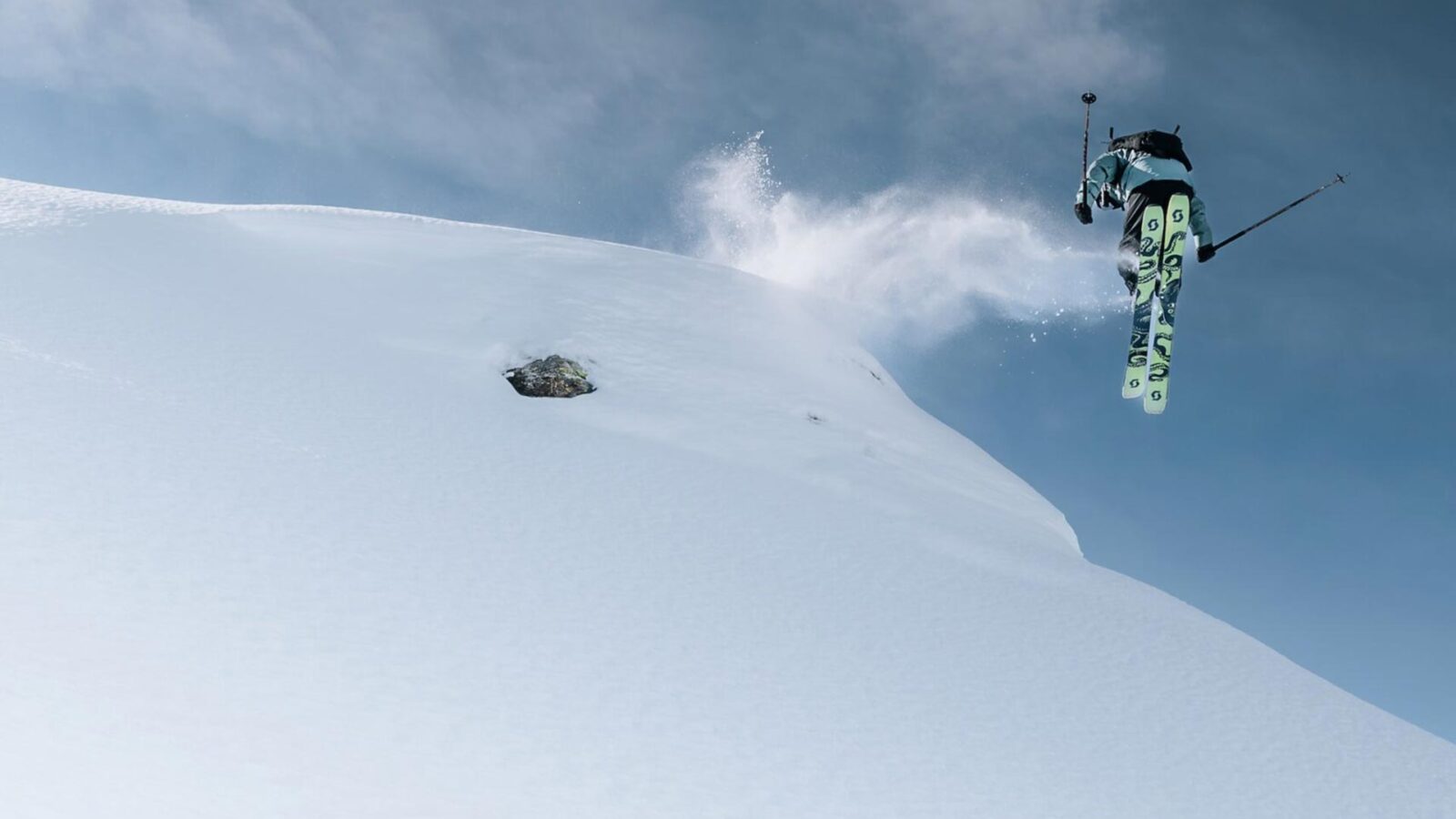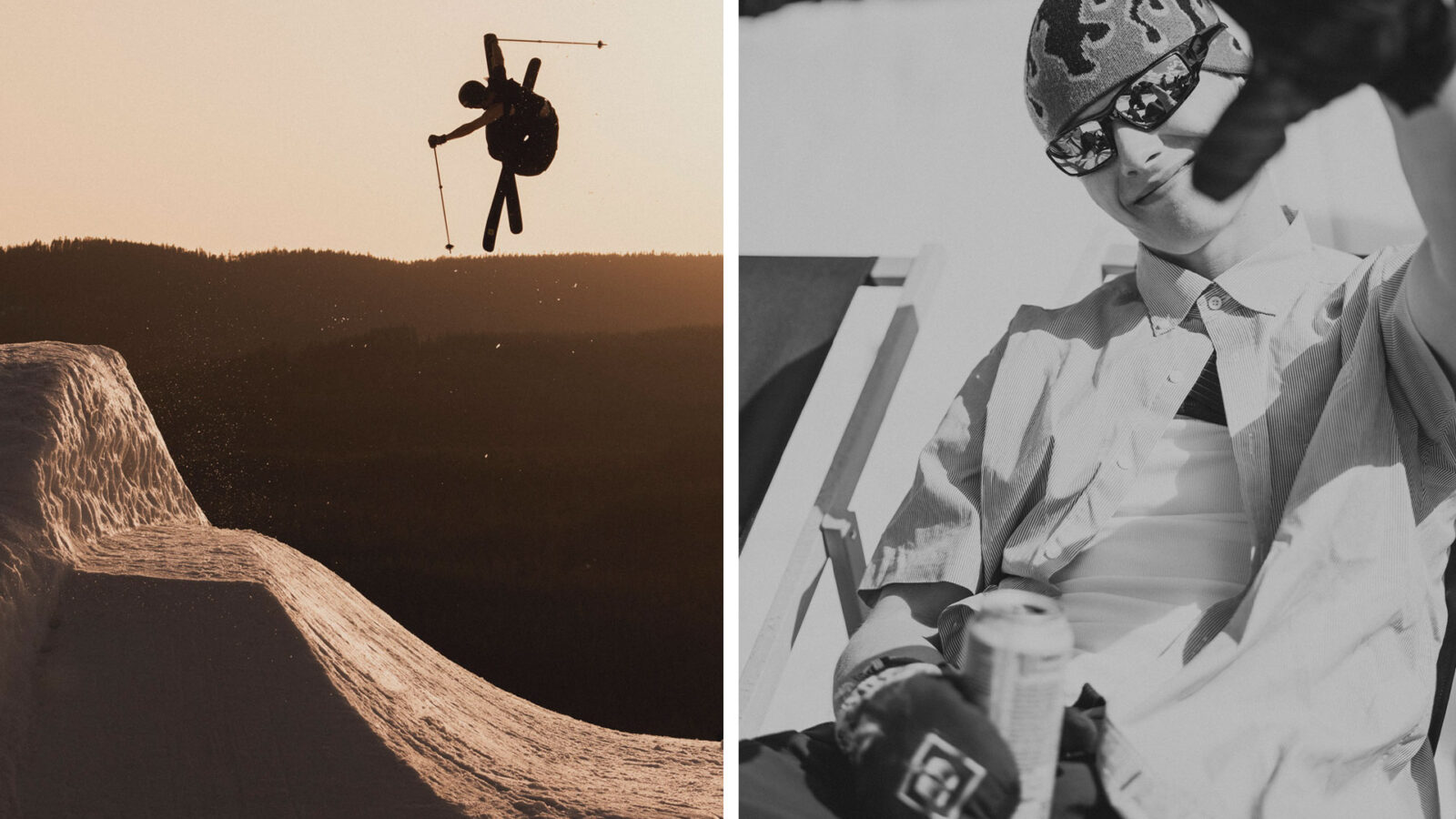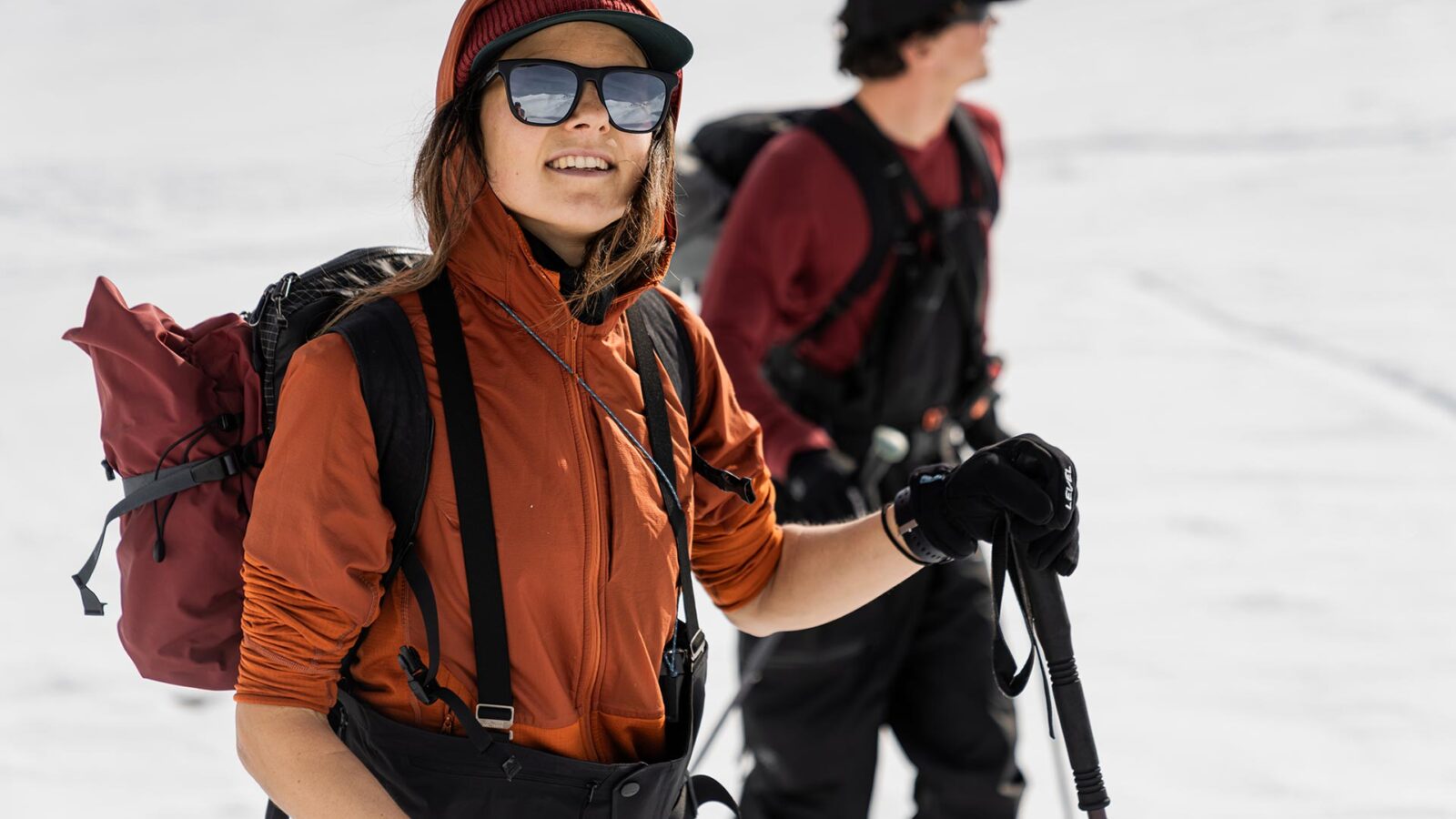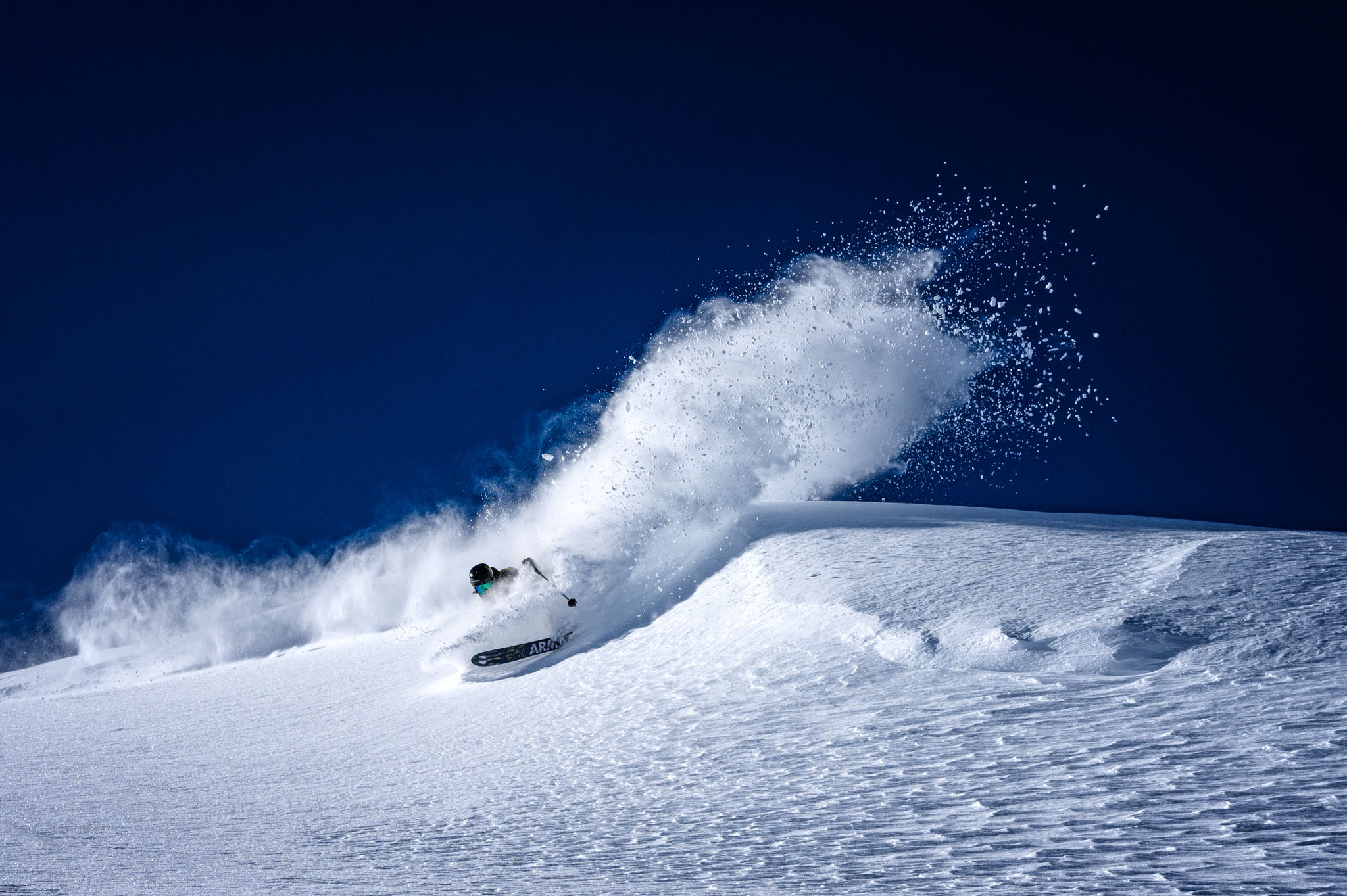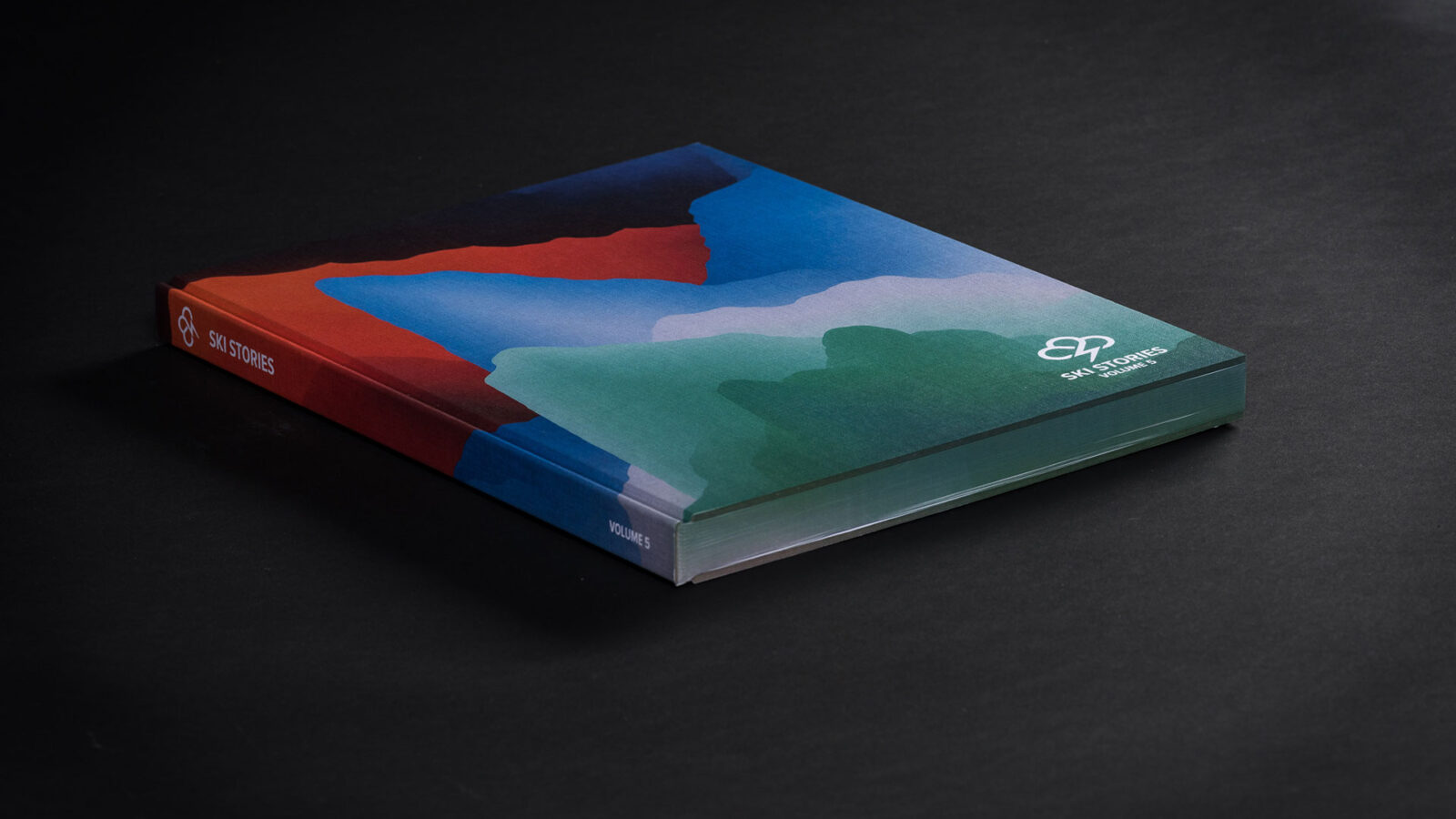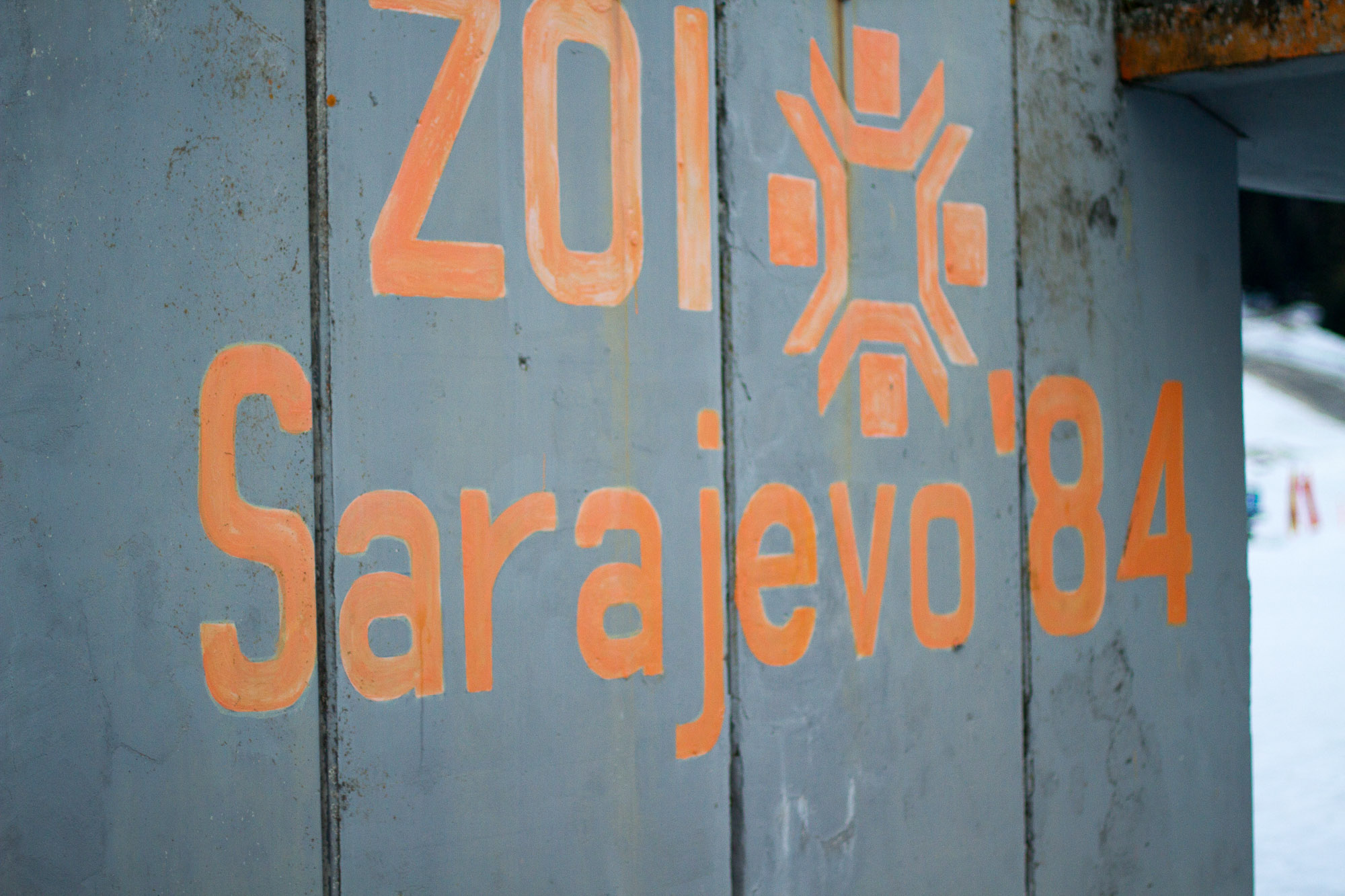
Stories
HighlightA Bosnian adventure
Digital Feature: Streets of Sarajevo
Bosnia. Sarajevo. Here we are. We are here. Why are we here? To ski the streets.
A few days ago I got the DM from Ahmet: “You should book a ticket to Sarajevo, it’s f*cking dope.” Time to pull the trigger on a plan we’ve been hatching for a while. Now, roughly 48 hours later, I am gawking out the window of a Croatian Airlines prop plane at snow-capped mountains as we make our approach to Sarajevo airport. Let the adventure begin.
Words & Photos: Ethan Stone
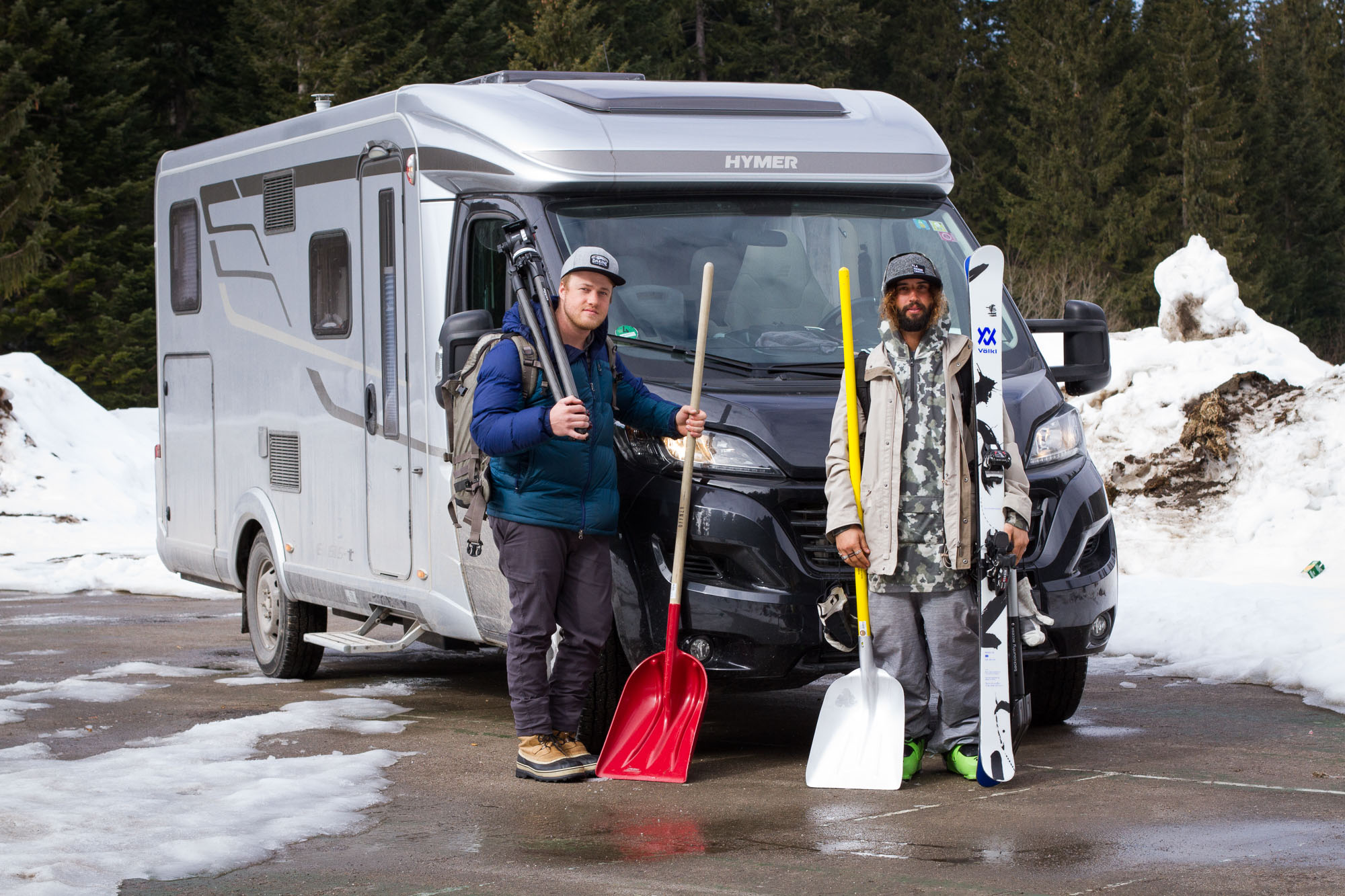
Euro Vanventurers: Jonathon Chandler, Ahmet Dadali and the trusty Hymer.
The VanVenture
The cast: Ahmet Dadali, leading role. Outspoken American freeskier and street skiing legend—and more recently, budding expatriate looking to spend most of his time outside of the States. This season Ahmet has finagled himself a camper van, and a plan to road-trip across Europe for three months in search of ski culture, street spots and untracked powder in out-of-the-way places. In the supporting role is Jonathon Chandler from Bend, Oregon: part-time military surplus dealer and principal cinematographer of Sage Cattabriga’s 2018 film “Elemental,” whom Ahmet has convinced to join on this crazy venture.
Since early February Ahmet and Jonathon have been zig-zagging across central and southeast Europe in search of the goods: Austria, Slovenia, Montenegro, and now Bosnia. After arriving a few days ago and seeing the potential, Ahmet has quickly assembled a strike team. I arrive the same day as Danny Kushnarevich aka Danny Kush, a Level 1 Productions filmer from Moscow who made the decision to come out on a moment’s notice. We also expect imminent reinforcement from Ahmet’s Völkl teammates Paddy Graham and Tom Ritsch.
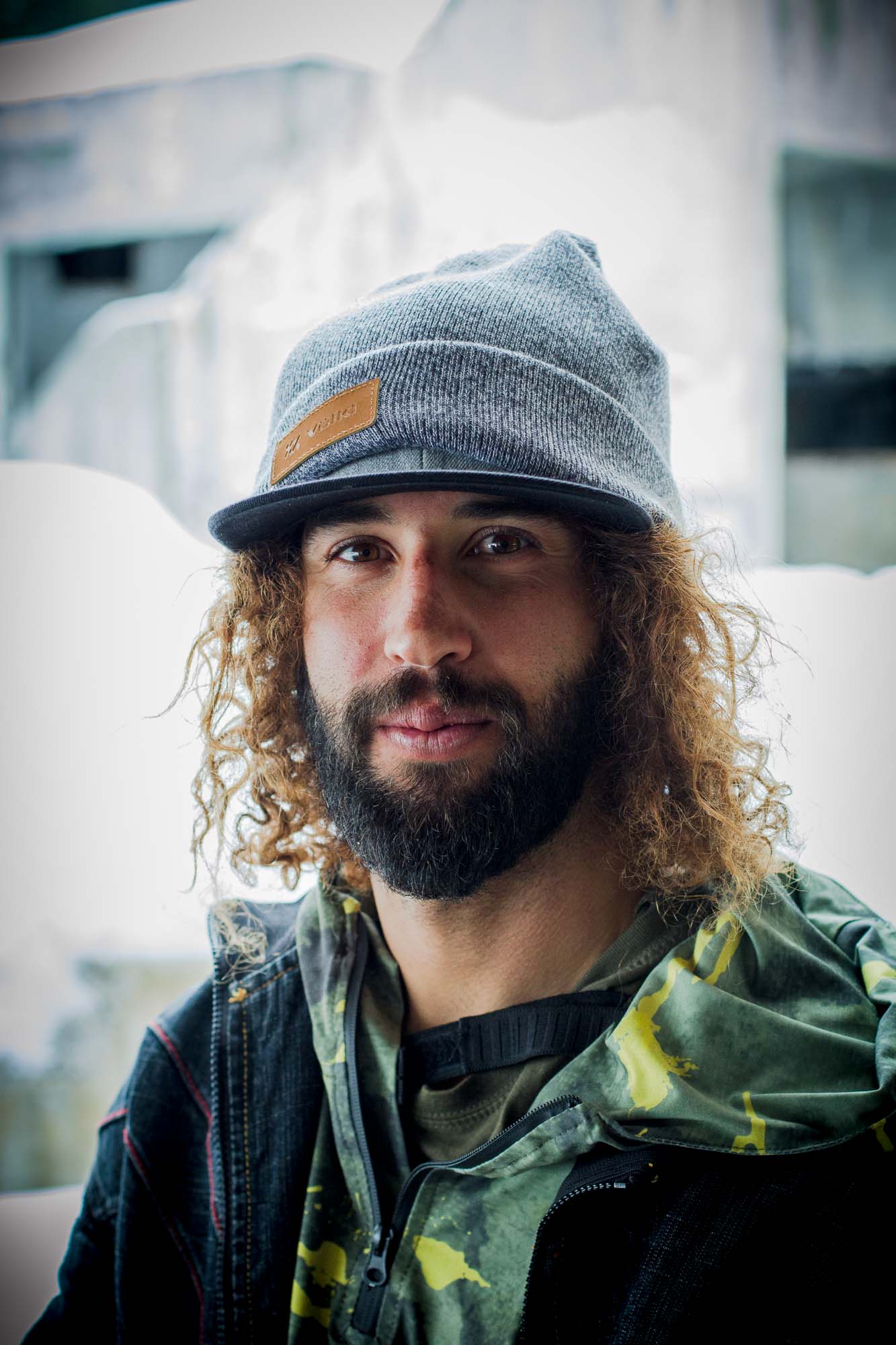
Ahmet Dadali.
Step 1: Acquire an AirBnB. Despite this being the “Euro Vanventure,” I don’t think we can sleep six dudes in this camper all week. Luckily, Sarajevo has the cheapest AirBnBs I’ve ever seen. We swoop on an apartment for the unheard-of price of €12 per night, close to the airport and on the tram line to downtown. The hijab of our incredibly friendly AirBnB host, Iman, and the evening prayer call of the nearby mosque are the first indications that we are in new territory here: the only Muslim-majority country in Europe.
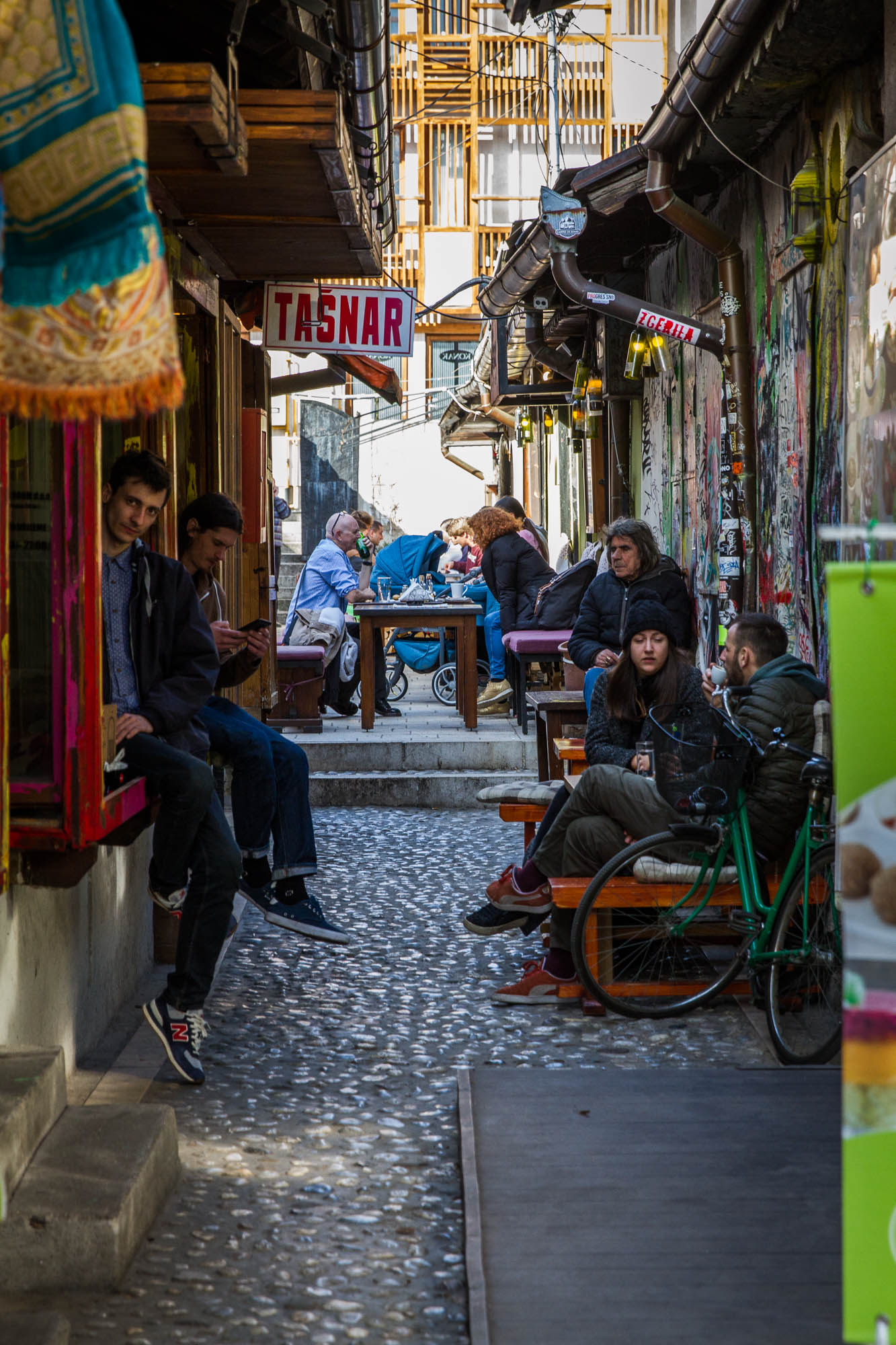
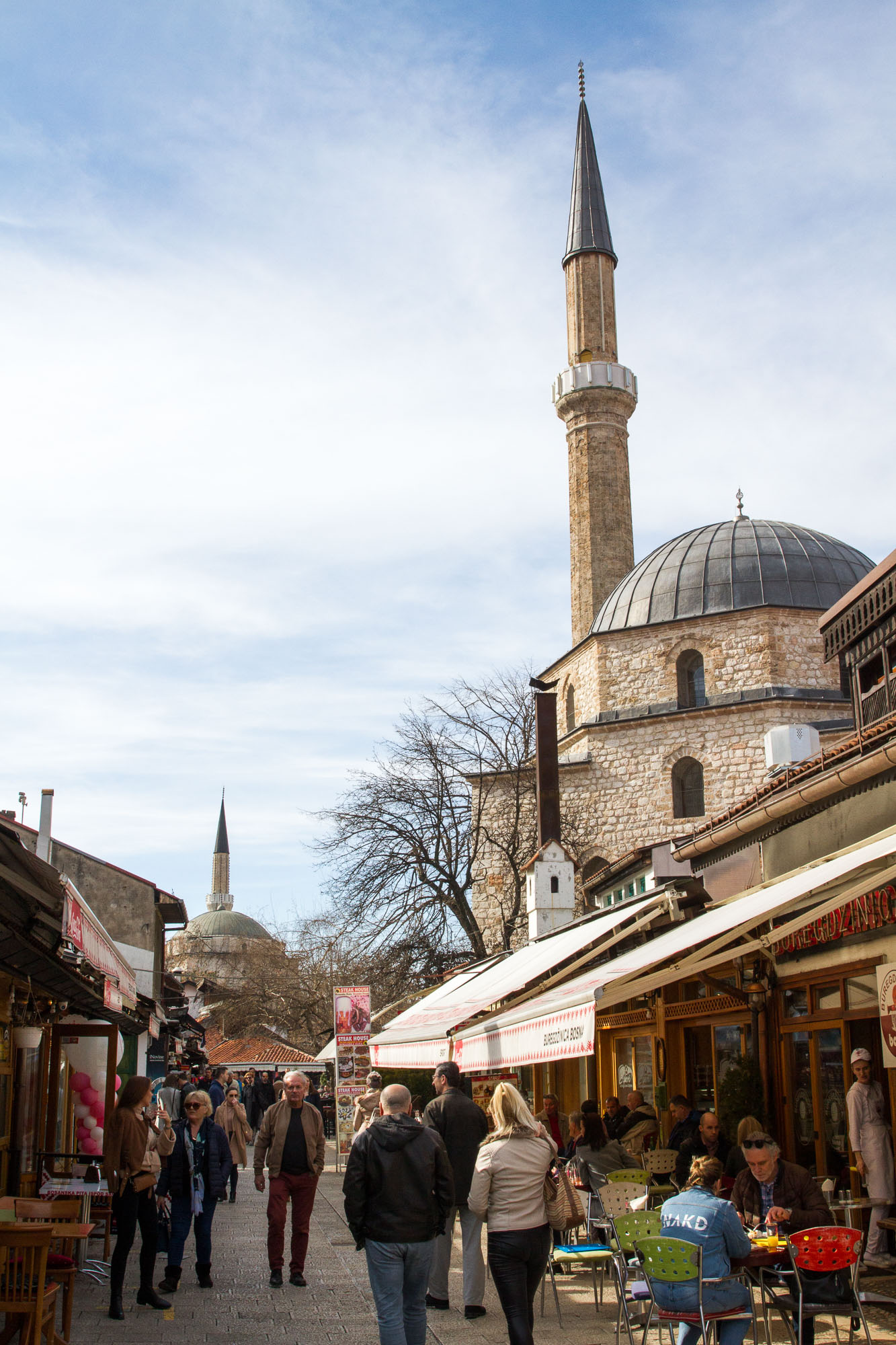
Can you ski in Sarajevo? Of course you can. The city hosted the 1984 Winter Olympics, after all. The ski resorts of Bjelašnika and Igman are a half-hour’s drive from the city, and our hosts tell us that Sarajevo itself usually has snow cover for much of the winter. We are by no means the first freeski crew here. Danny Kush shows us an edit from the Finnish squad Nipwitz, who nabbed meter-deep powder in the city in 2012. The French crew Gpsy Feelin was here a year later, filming for their movie Moon Shine, and Teton Gravity Research came with Joss Christensen, Chris Laker and Karl Fostvedt in 2014. As recently as last week, the Innsbruck crew el.makrell was here on their Interrail ski trip.
Day 1: Welcome to Igman
Our first spot is an abandoned hotel on the road to the ski resort, sessioned before by many of the crews before us, but still offering limitless potential. It is a towering, slumping colossus, the remains of a once grand hotel; a grim reminder of the cruel irony of Sarajevo, the Olympic City that was, less than a decade later, torn apart in the most vicious conflict in Europe since the Second World War.
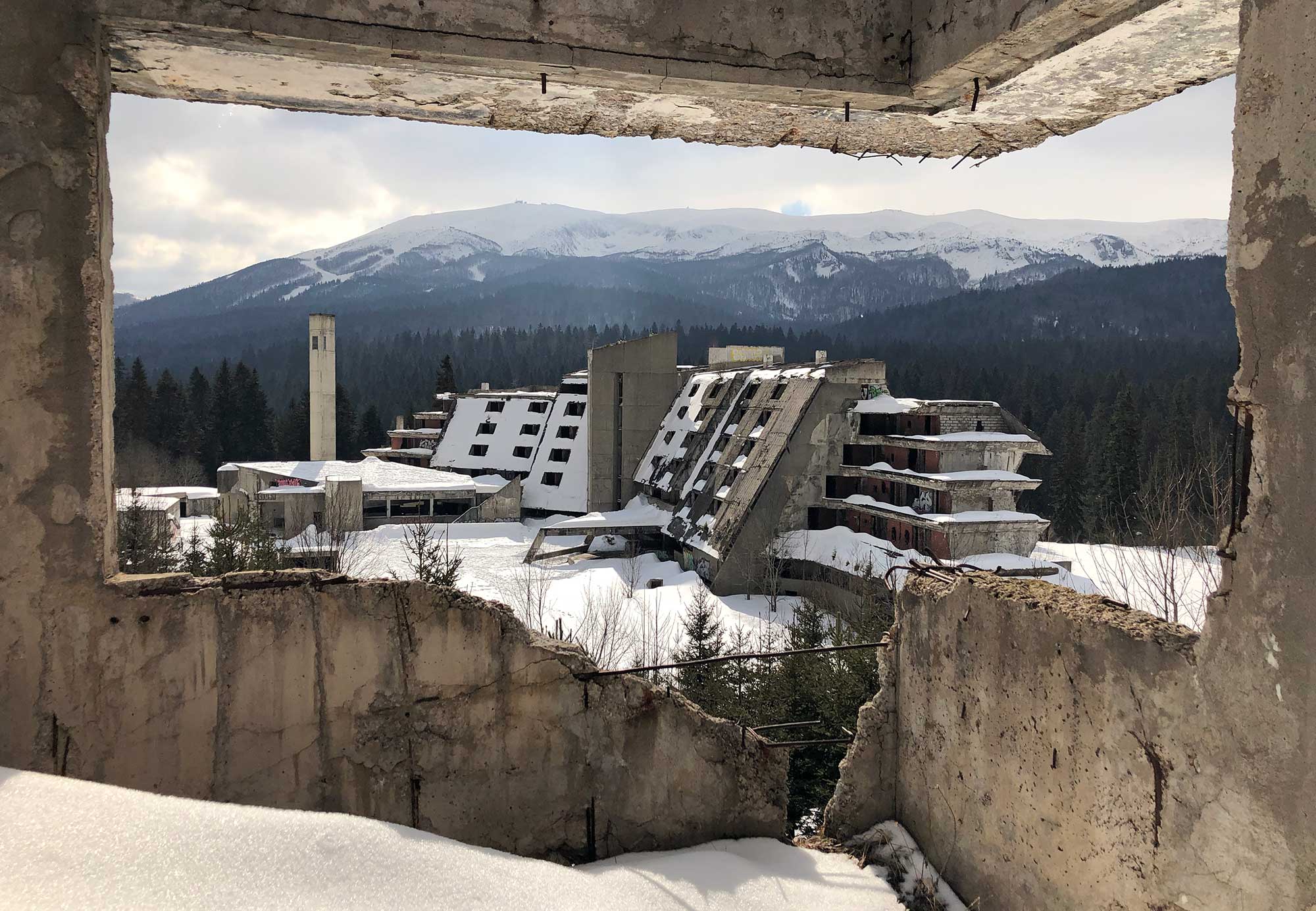
Once an Olympic hotel, then a military prison, now a playground for street crews: the ruins of Hotel Igman.
Shattered glass and crumbled brick crunch underfoot as we explore the shattered remains of the hotel. The main floor has been converted into a paintball venue, but bullet-scarred walls and starburst shell impacts remind of the not-so-distant times when the battles here were fought with live munitions. The hotel was used as a prison by the Bosnian Army during the war, and prisoners were tortured in the eerie ruins that we now have come to use as a playground. It’s all a bit surreal. We will learn more about this unimaginable tragedy soon — but for now, let’s make the best of a bad situation, and put these desolate walls to use as a street-skiing venue.
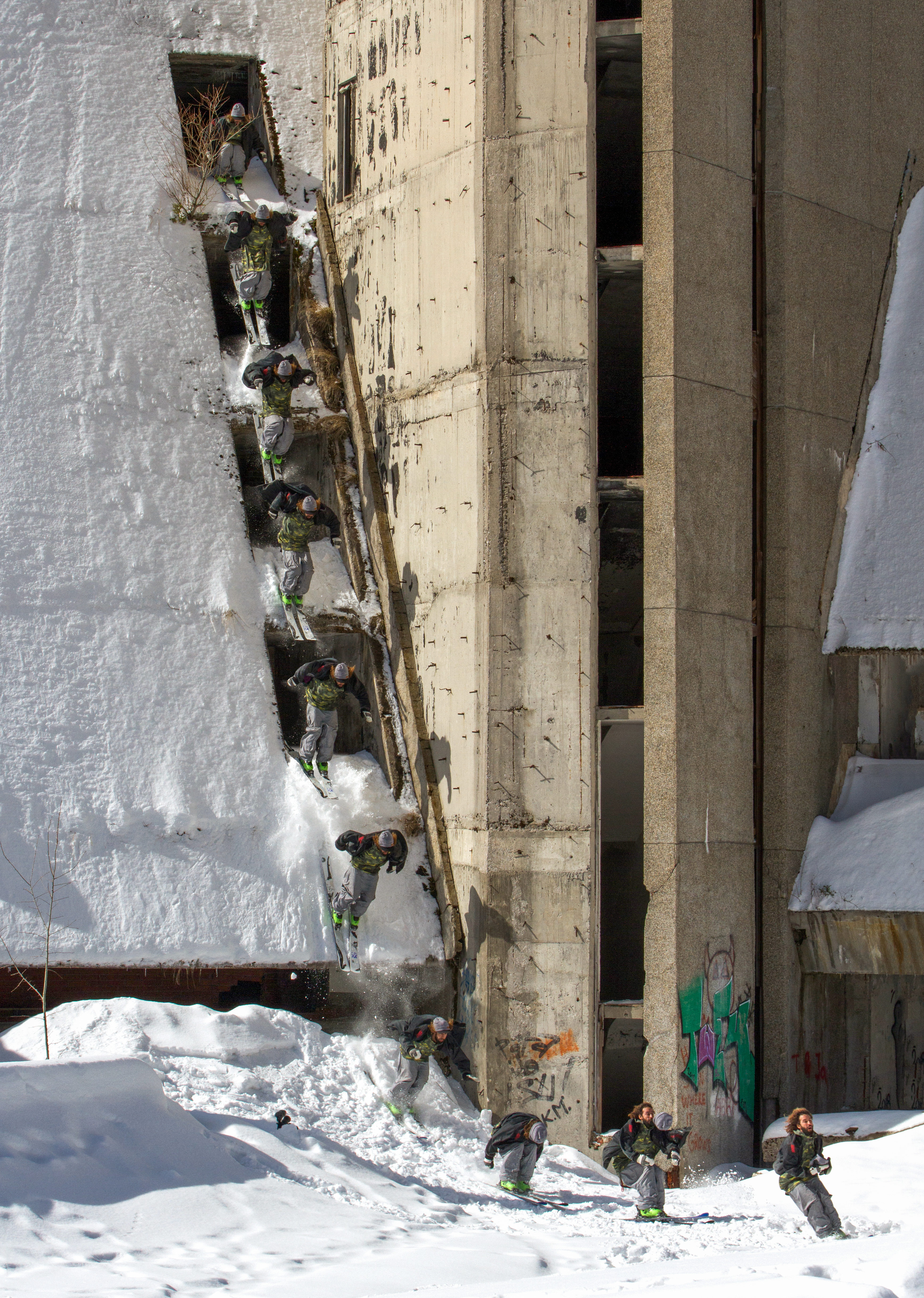
Ahmet gets the first shot of the week, complete with a clutch beanie catch at the end.
A recent snowfall has caked the hotel’s slanting exterior in white, with windowsills and balconies turning into snow pillows. To start things off Ahmet has selected a “pillow line” down the side of the building, dropping from four stories up. He warms up a few times from the third story, then goes for the drop from the top, nailing it first try. “One and done!” High fives all around, and we’re on to the next task: another window drop, this one to a jump off the roof the hotel’s back patio, where Ahmet stomps a rodeo 5 after a few tries. Two shots in the bag: a solid day. We call it good and head back to Sarajevo, where Tom and Paddy are waiting for us at the airport. The squad now complete, we hop on the tram into the old city for dinner. We marvel at mosques and churches, bullet-pocked buildings, buy Bosnian SIM cards and scarf down heaping plates of cevapi before retiring for the night.
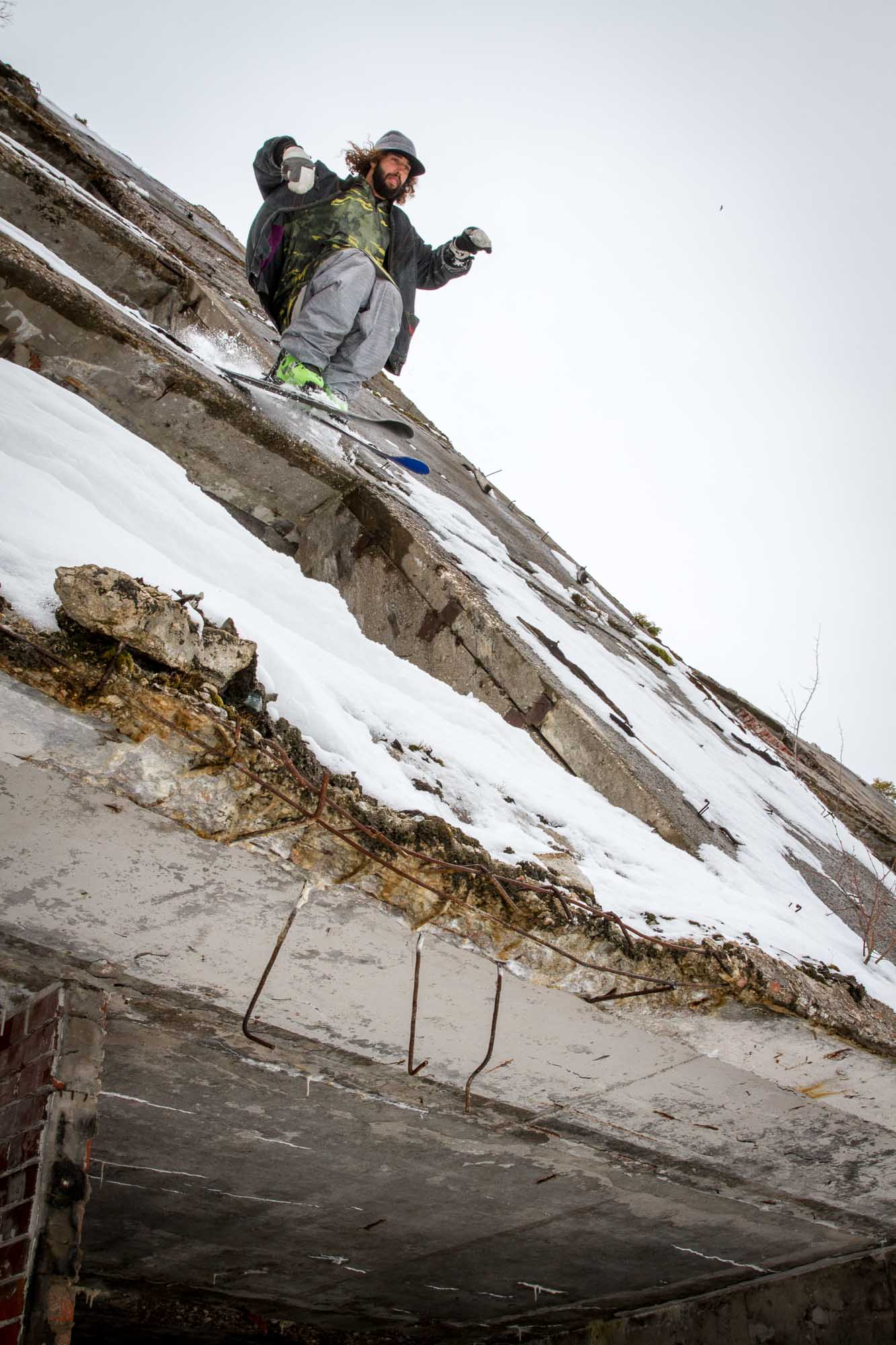
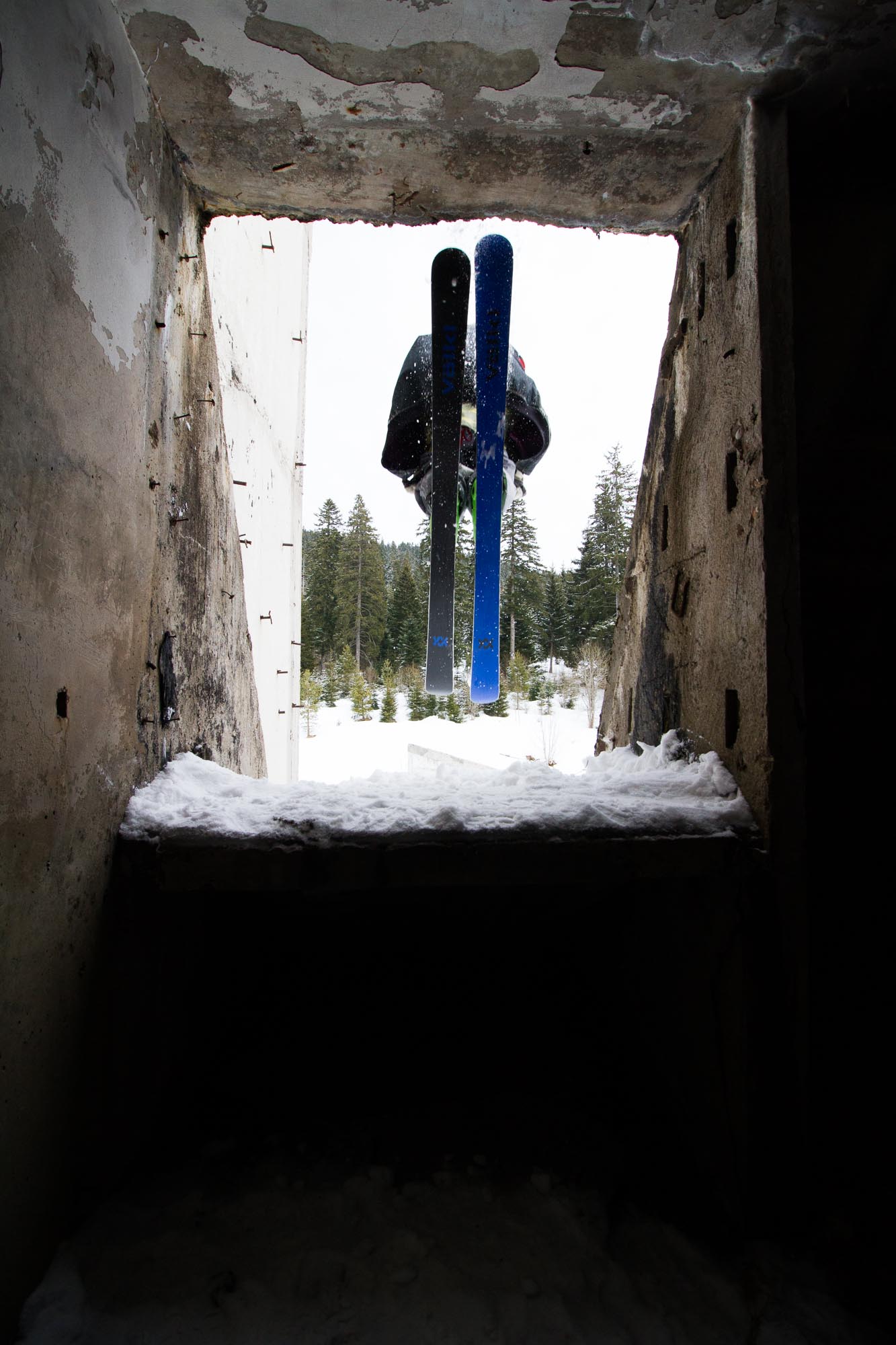
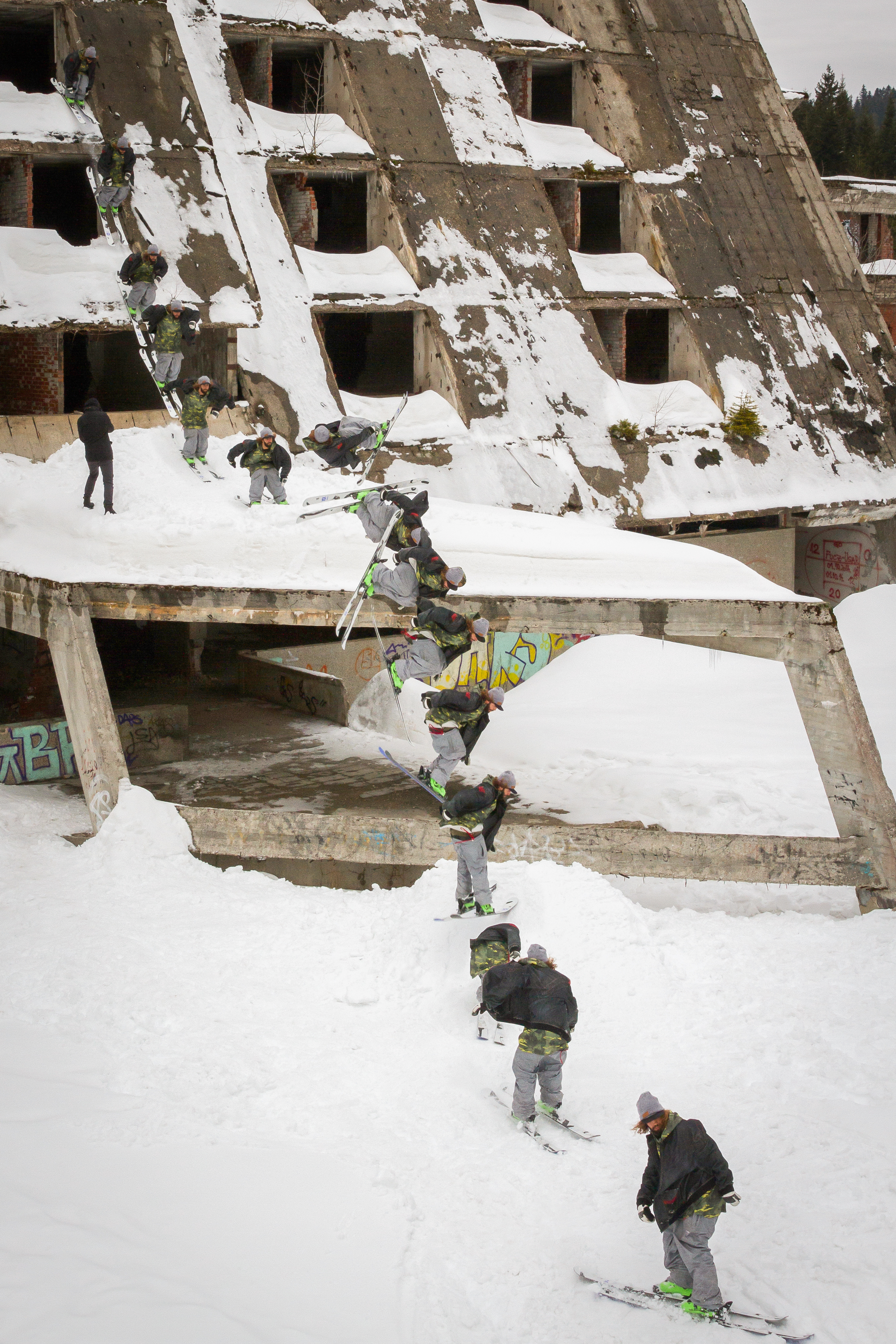
Ahmet´s a guy who doesn´t call his tricks before his drop, so you never quite know what´s coming. I figured he´d be happy with a 180 or a 5 on this drop, but then he brought out the rodeo.
Day 2: Concrete Tranny Finding
The sun’s shining and we’re back at the spot, where Tom and Ahmet are sessioning a quick line: jump up onto a roof, then jump off it and jib a concrete slab on the way down. Tom is raring to go on his first day and quickly stomps a few different tricks, while Ahmet slams repeatedly trying to snipe the concrete tranny to switch. He rings his dome multiple times, but apparently it’s not enough to convince this street purist to don a helmet. After a needed adjustment to the landing, Ahmet gets his trick, while Tom gives Ahmet’s roof-jump line from yesterday a try.
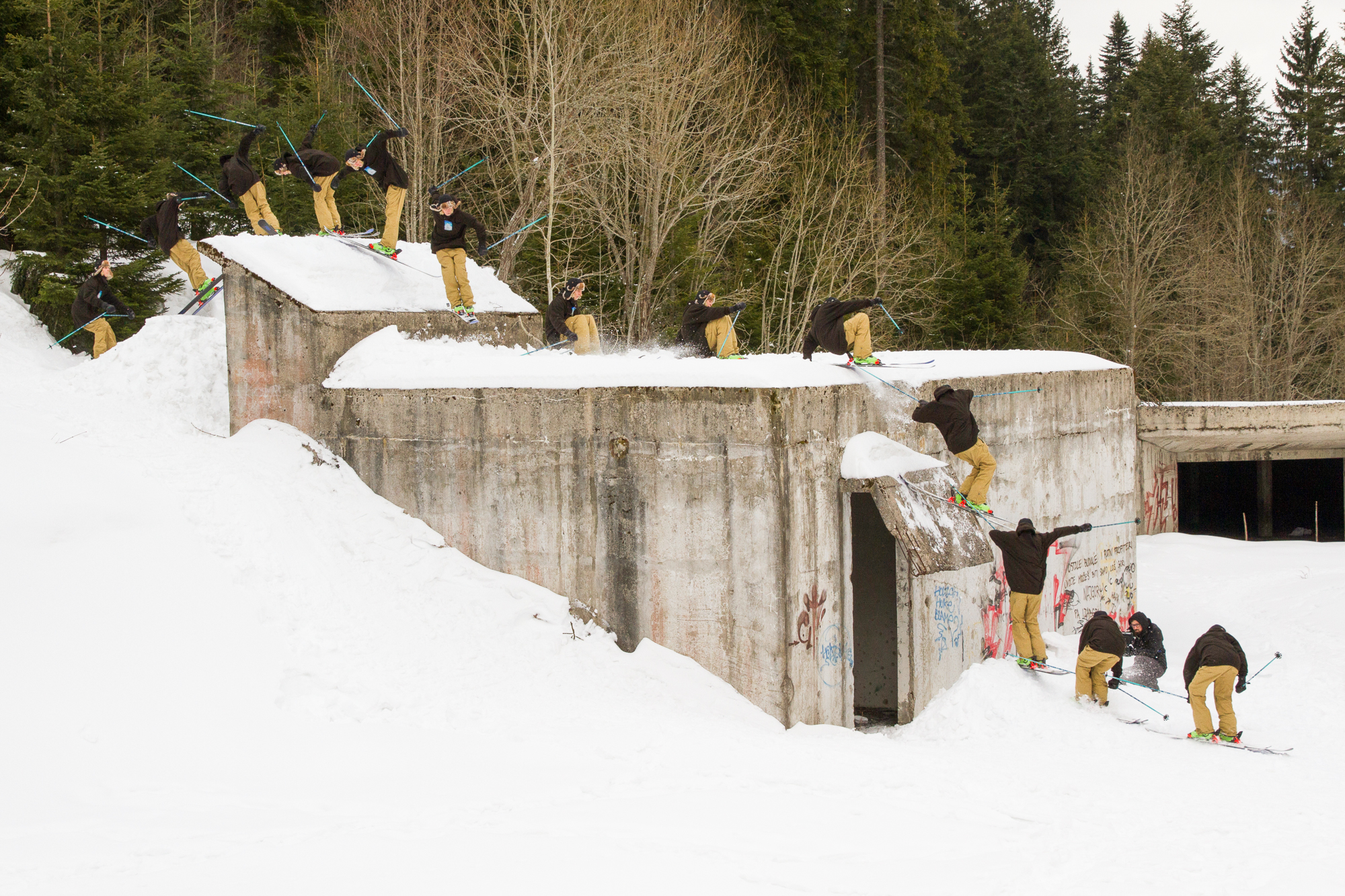
If you want to piss off Tom Ritsch, call him a "jibber." He really loves that.
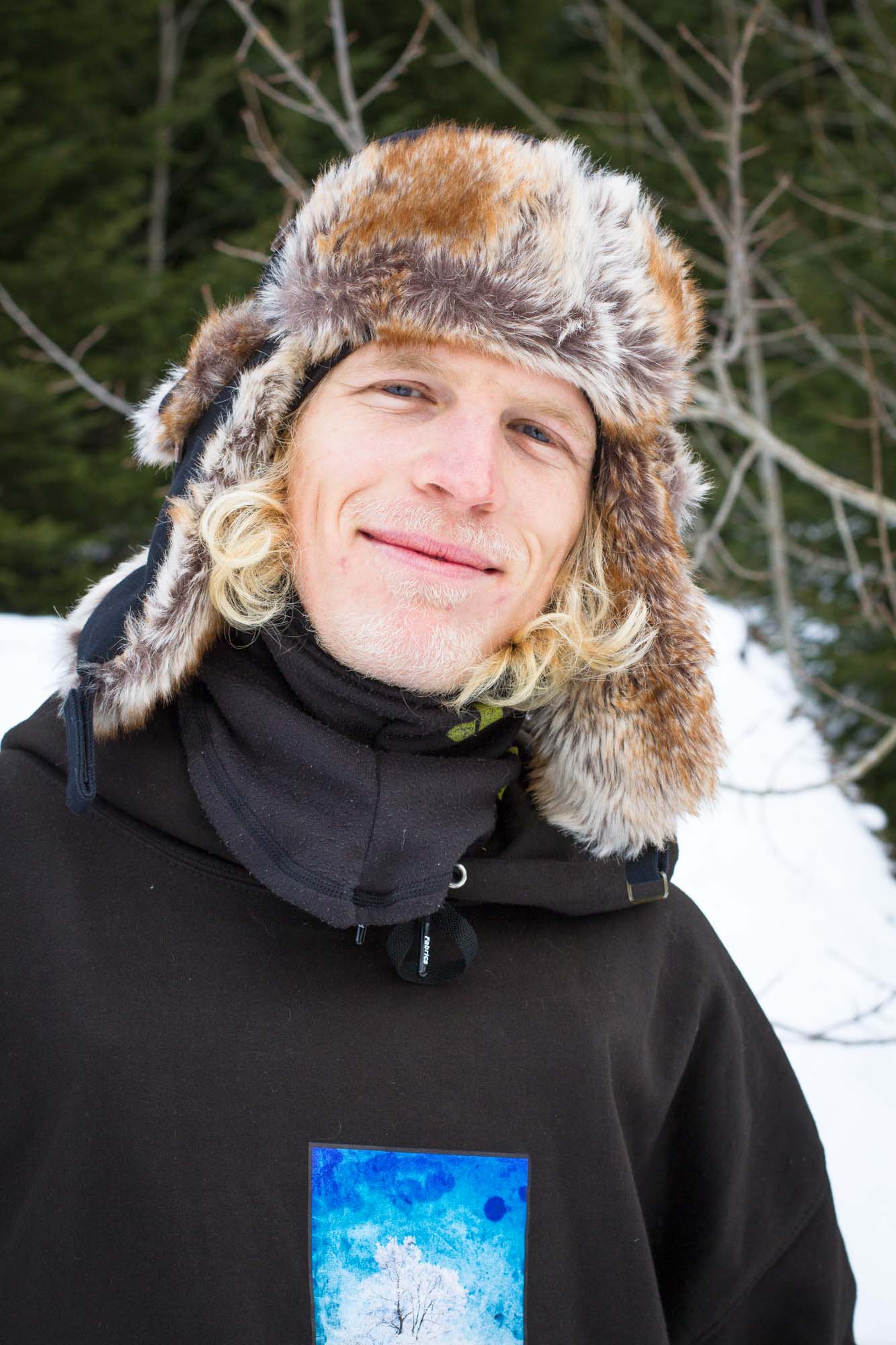
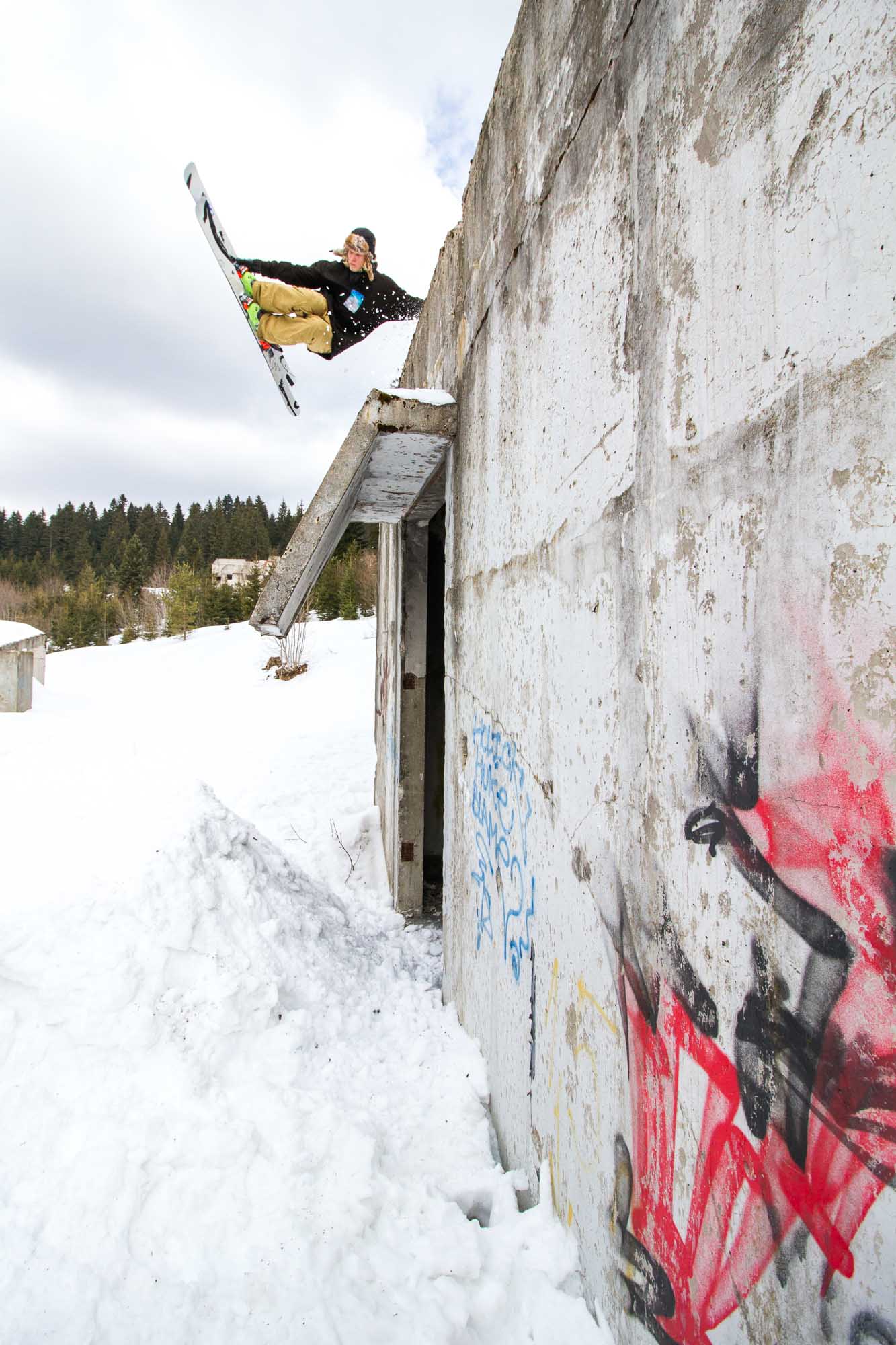
How to describe Tom? He´s not a jibber or a park skier - not exclusively, anyway. He´s not a "young gun," nor is he an up-and-comer. He´s just—as he himself puts it—"an all-round kind of guy."
It’s fairly quiet at the spot. Every so often, a group of sightseers wanders by. Today it’s an entire class of Dutch school children. They stare languidly at our motley crew of skiers and filmers, and Ahmet scores a few new Instagram followers. Otherwise, it’s just us and a pair of hawks circling overhead. Paddy and I explore a nearby building and discover old bullets still lodged in the walls. Are they from the war? Someone’s target practice, or a military encounter? It’s tough to say.
As the afternoon wanes, Ahmet wants to session a feature he’s prepared in advance: a sketchy-looking wallride with a gap to landing on an angled concrete wall with a thin snow cover. Tom gives it a few test hits and says, “Yeah, I think I’m good on that.” The setup seems questionable, but Ahmet knows exactly what he’s doing — after a few warm-ups he’s bouncing off the wall several meters up and finding perfect tranny on the landing. Eventually he turns to the crew and says, “Let’s shovel the snow off the landing.” As Paddy recounts it later, “That was the moment that it got real.” With some serious concern for Ahmet's well-being, we remove the snow from the landing to leave bare concrete, and watch with bated breath as he continues to hike the feature tirelessly. Predictably, he stomps an absolute banger a few tries later.
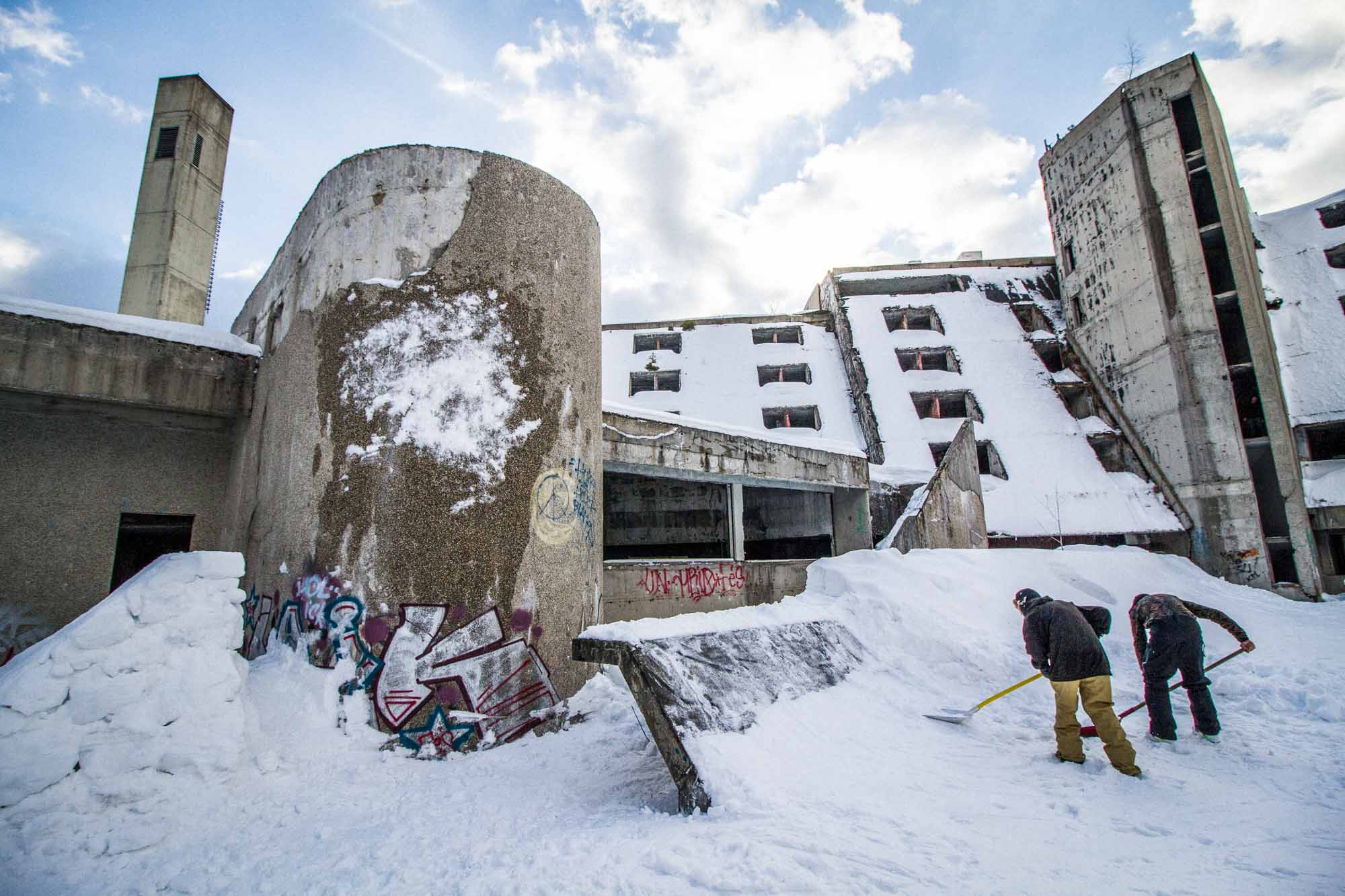
Shovel the snow off the landing?? If you say so...
The setup seems questionable, but Ahmet knows exactly what he’s doing.
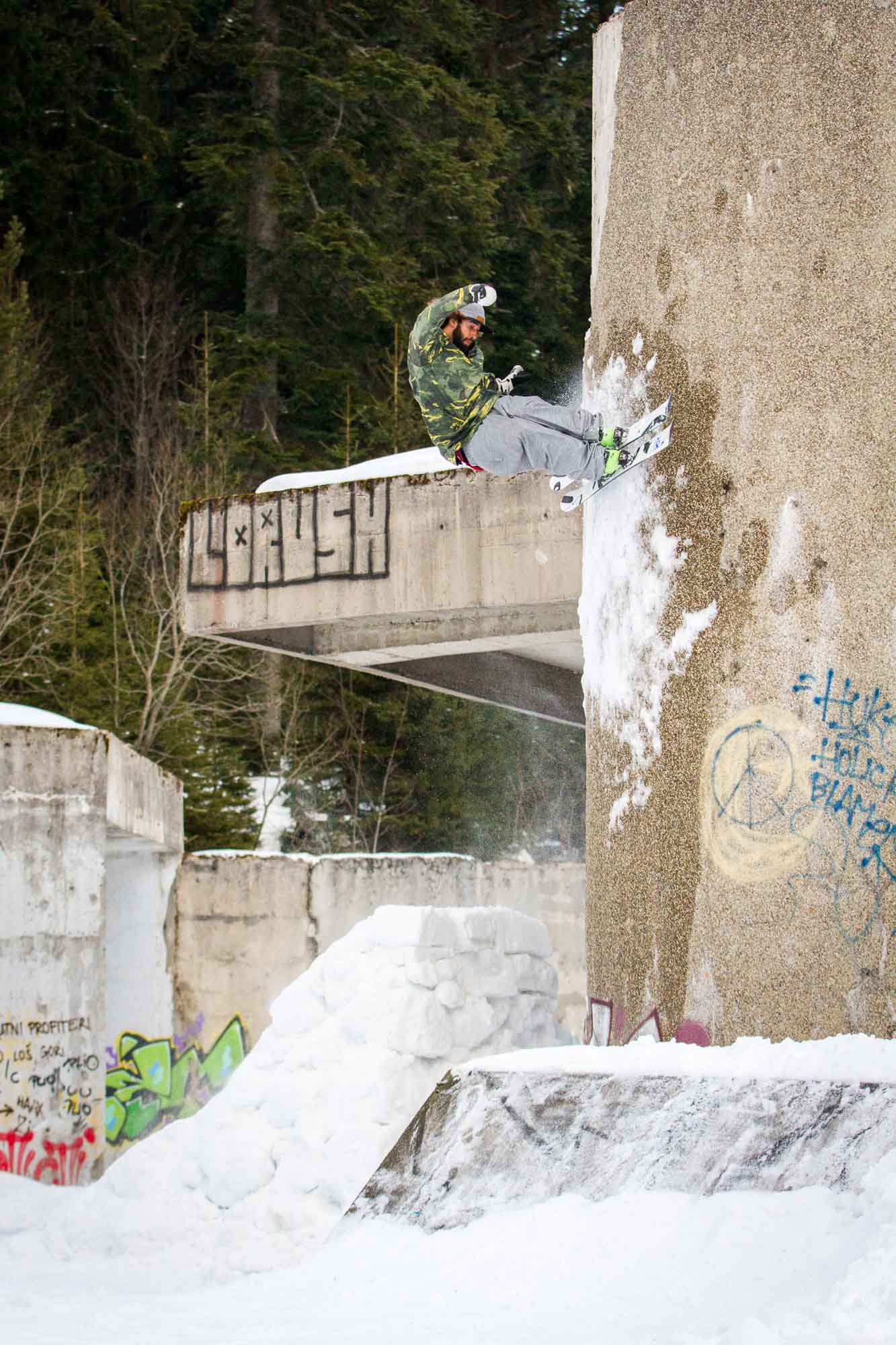
Ahmet tames the beast.
The evening ends in a true mystery: somewhere along the drive back home, Tom’s bag disappears from the (locked?) storage locker of the camper. It’s discovered along the road by a kind soul who contacts Tom via Facebook and returns the missing gear. How did the bag fall out of a closed compartment? Was the door not quite shut, swung open on a turn and dropped the bag out, then swung shut? We have no answers, but at least Tom has his backpack and wallet back. Dinner is takeout from the Syrian place near our apartment: tasty falafel, kebab and hummus to cap off a long day.
Day 3: Handplants and Brick Stalls
We return again to Igman, where Tom warms up with a handplant session on the wall Ahmet was jibbing yesterday. The session then moves to a small quarterpipe transfer over a sketchy air shaft dropping deep into the parking garage below — not anything you want to fall into. Undeterred by this gaping pit of doom, Tom and Ahmet get their tricks on the setup, then we pack up and head up the road to check for new spots. A crumbling brick building, looking like its been falling apart since long before war, becomes the next venue.
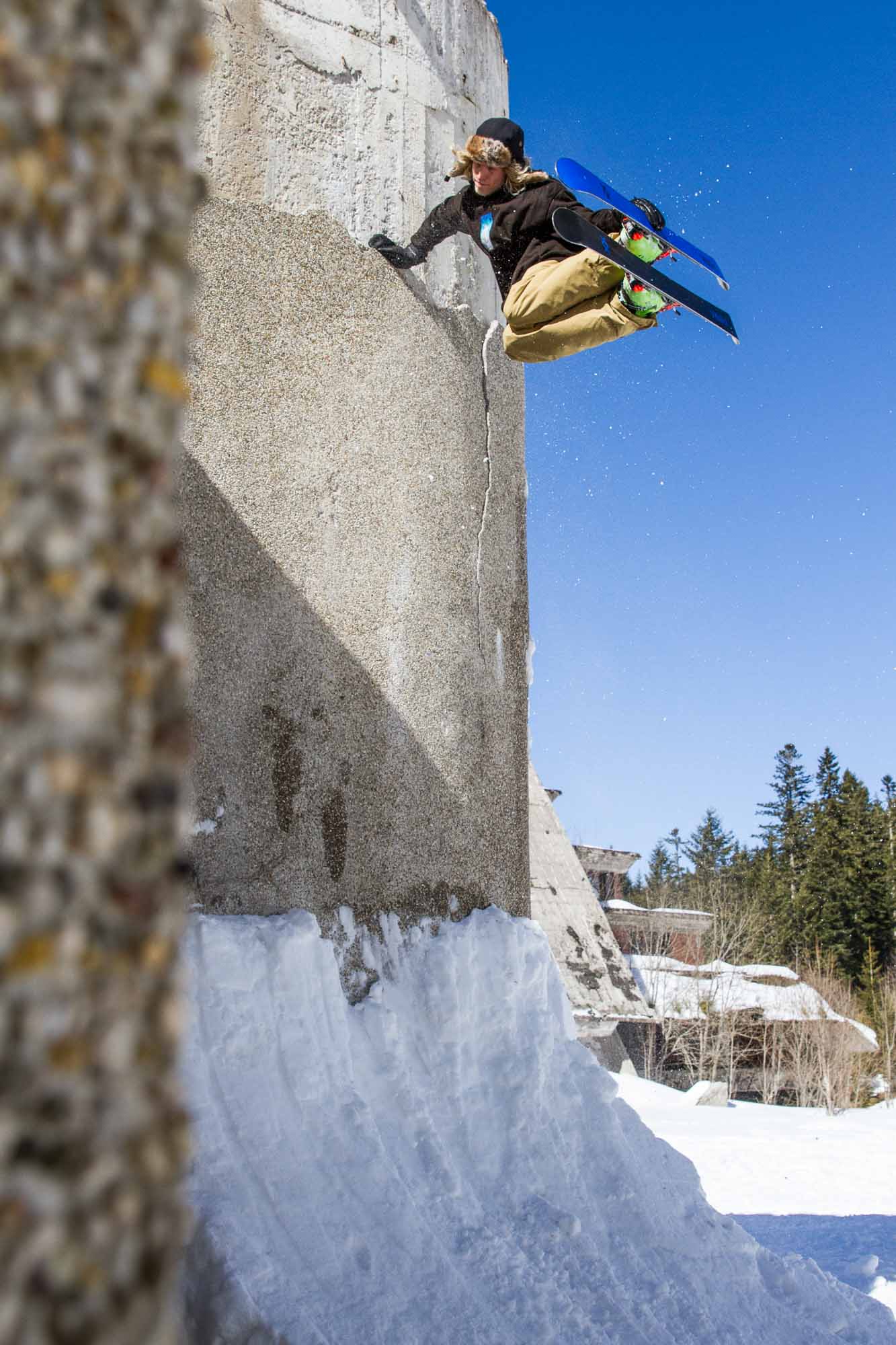
I stole this angle from Paddy, who took a better picture than this with his iPhone. Damn kids and their smartphones.
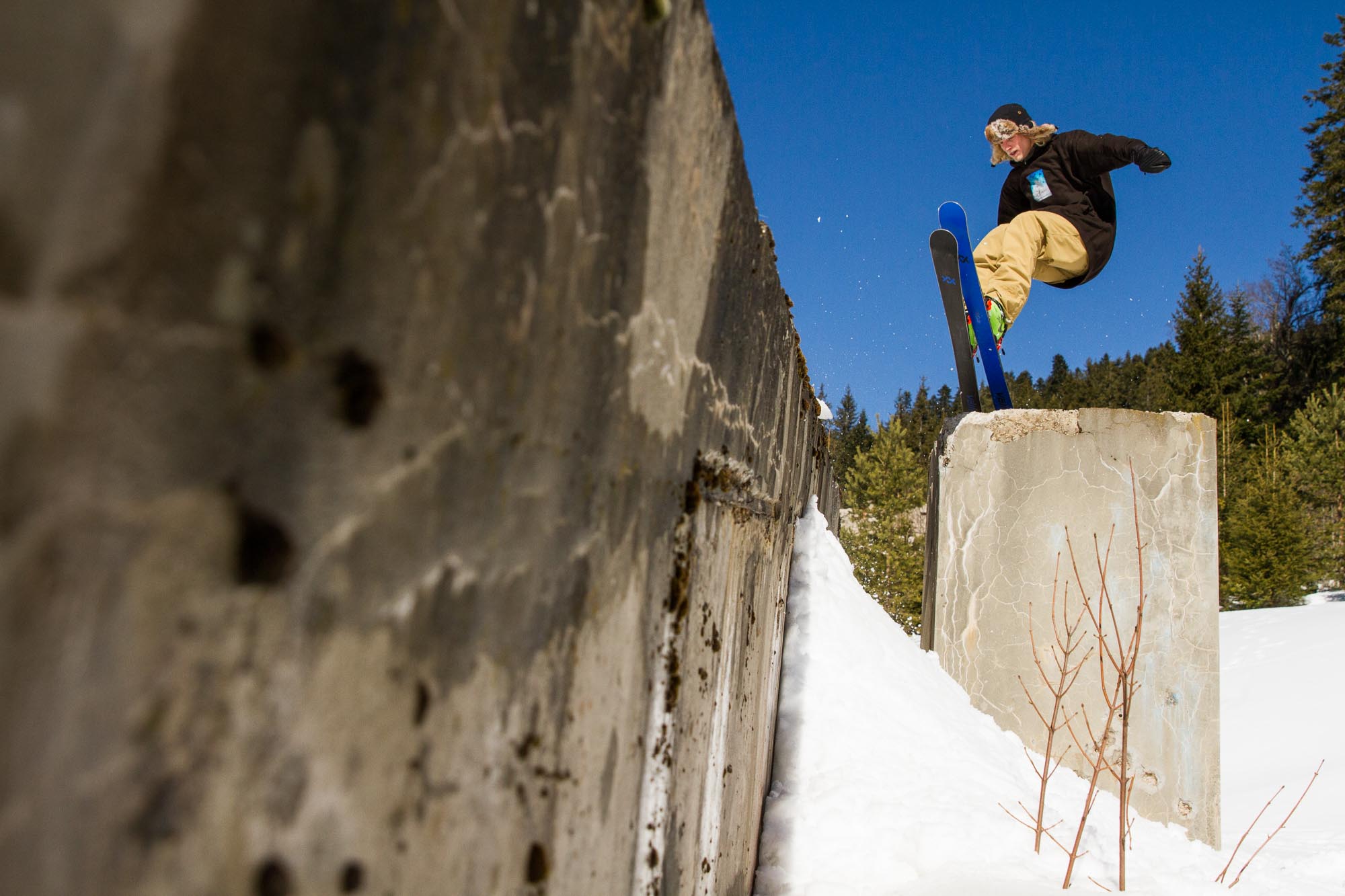
Tom, chimney tapping.
Feature choice is an important part of any urban skier’s approach, and Ahmet is a master of the unlikely, unique take on a spot. On a trip to Slovenia back in 2014 he shared the essence of his philosophy with me: he’d rather ski a line where the “trick” is just getting to the end, rather than do a standard spin-on, switch-up, spin-off trick on a plain old rail. Here in this brick ruin, Ahmet’s line is this: drop in to stall on a brick ledge, drop to reverse tranny, then drop out of the window underneath. It’s a bit wacky to contemplate but sure enough, after several tries Ahmet’s vision pays off again. Tom is somehow able to squeeze his long frame through the low window for a few shots, and Paddy — playing more of a support role on this urban jaunt so far — gets in the mix, too.
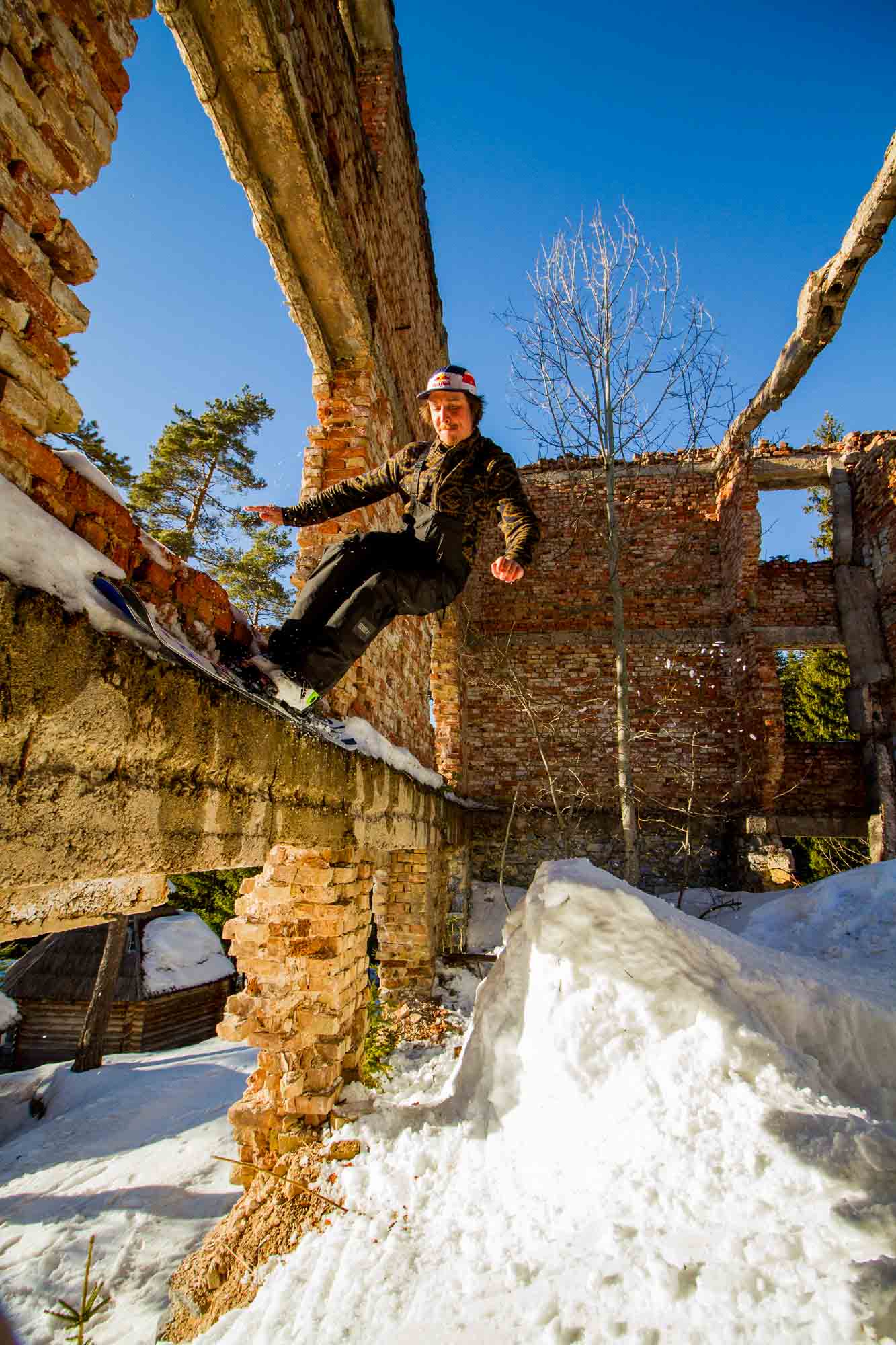
Paddy may be more comfortable on BC booters than street features these days, but that didn´t hold him back from trying out this spot.
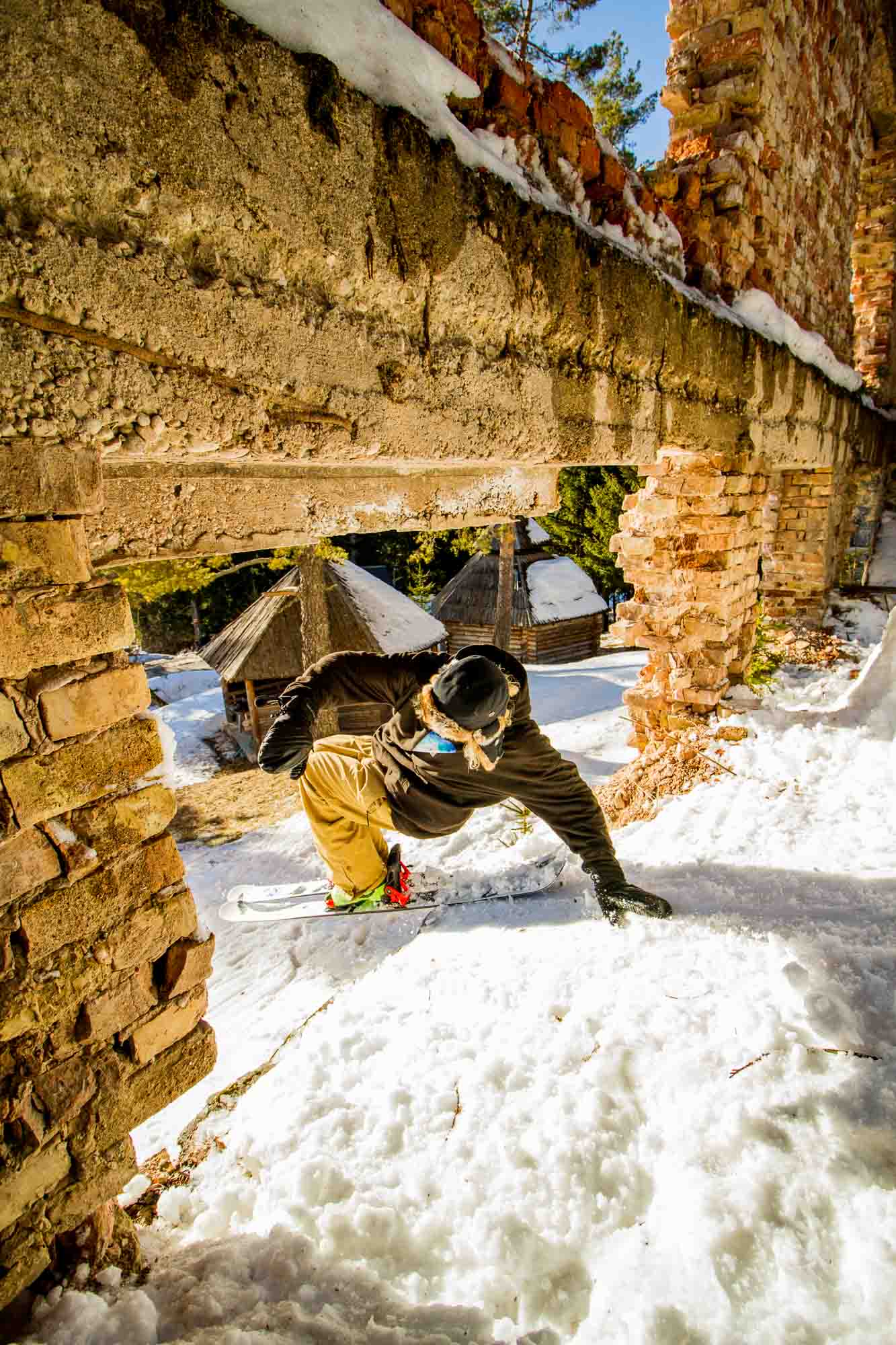
Tom fits his tall frame through a small window.
Day 4: The big line
It’s Tom and Paddy’s last day in Sarajevo with us, and the trip’s biggest feature is on the schedule: a five-stage “pillow line” from the top of the abandoned hotel to a sizable bomb drop out. We check the spot in the morning, decide to wait till the afternoon for the best light, and return to the previous day’s brick spot, where we befriend a few local forest workers who aren’t sure what we’re doing climbing around in the abandoned ruins. With the help of Google Translate we convince them of our harmlessness, and soon they’re our biggest fans, watching on with big grins as the boys navigate their way through another window-drop line.
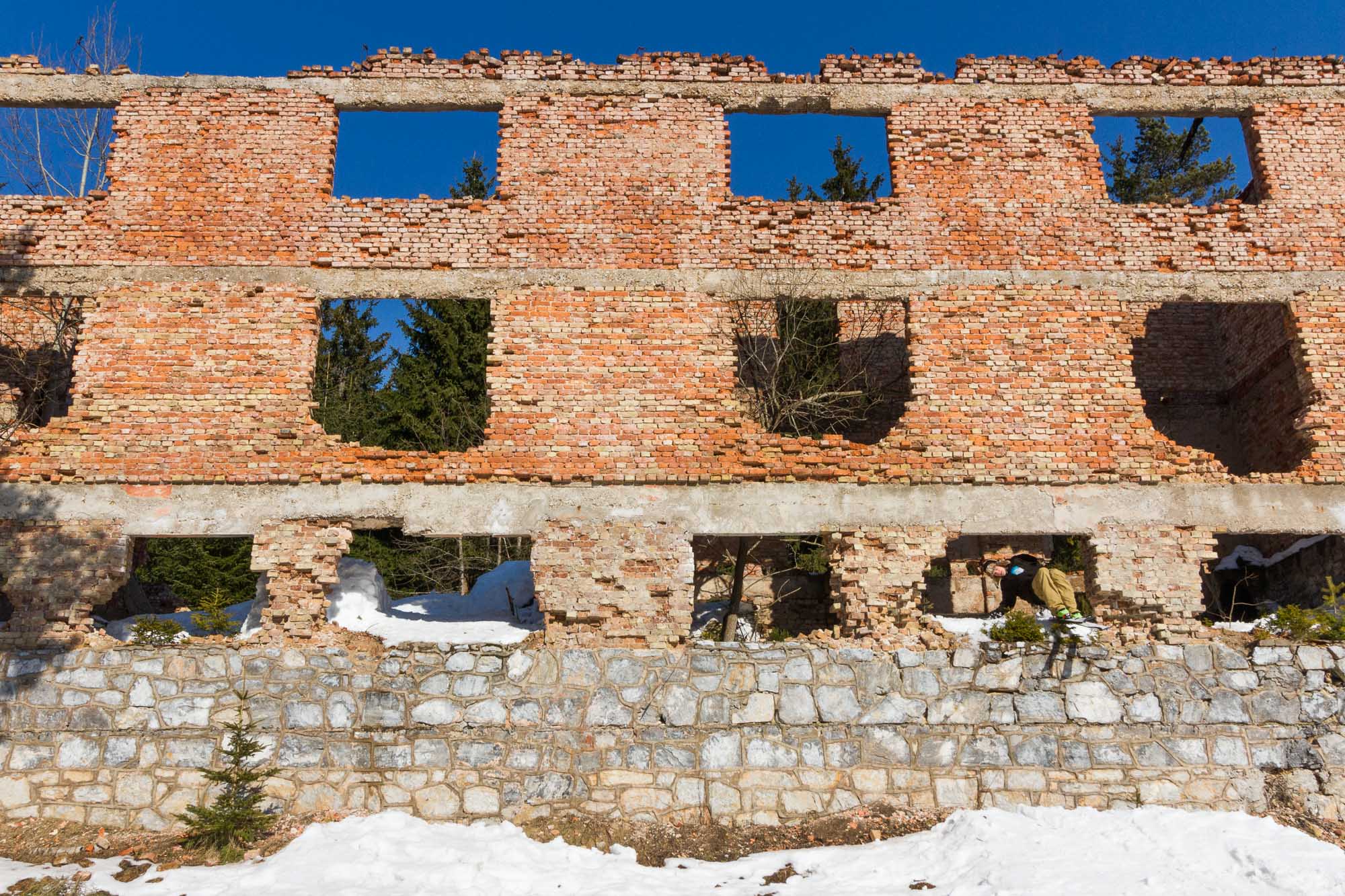
Tom, unfazed by the low clearance.
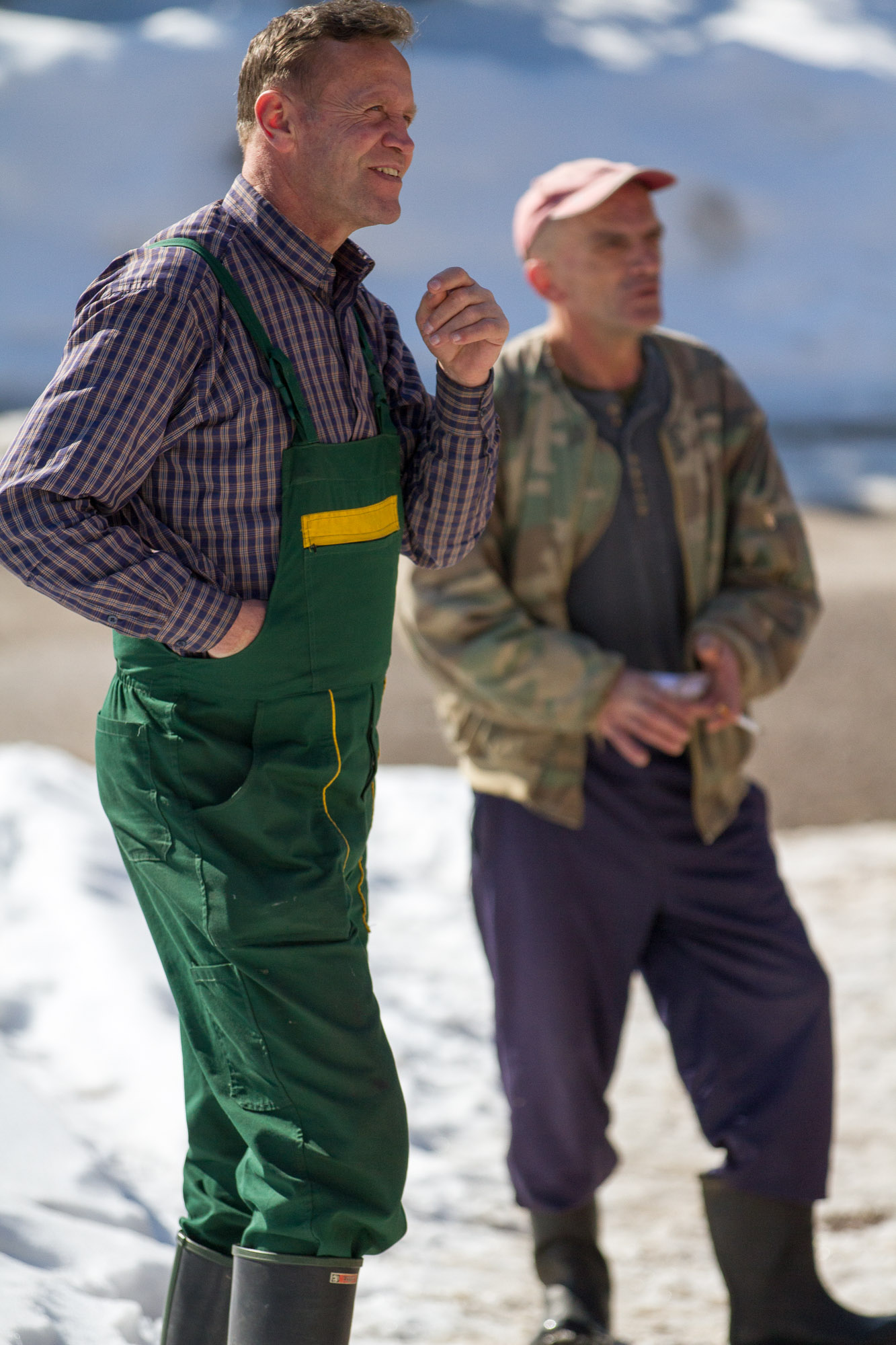
Our new fan club.
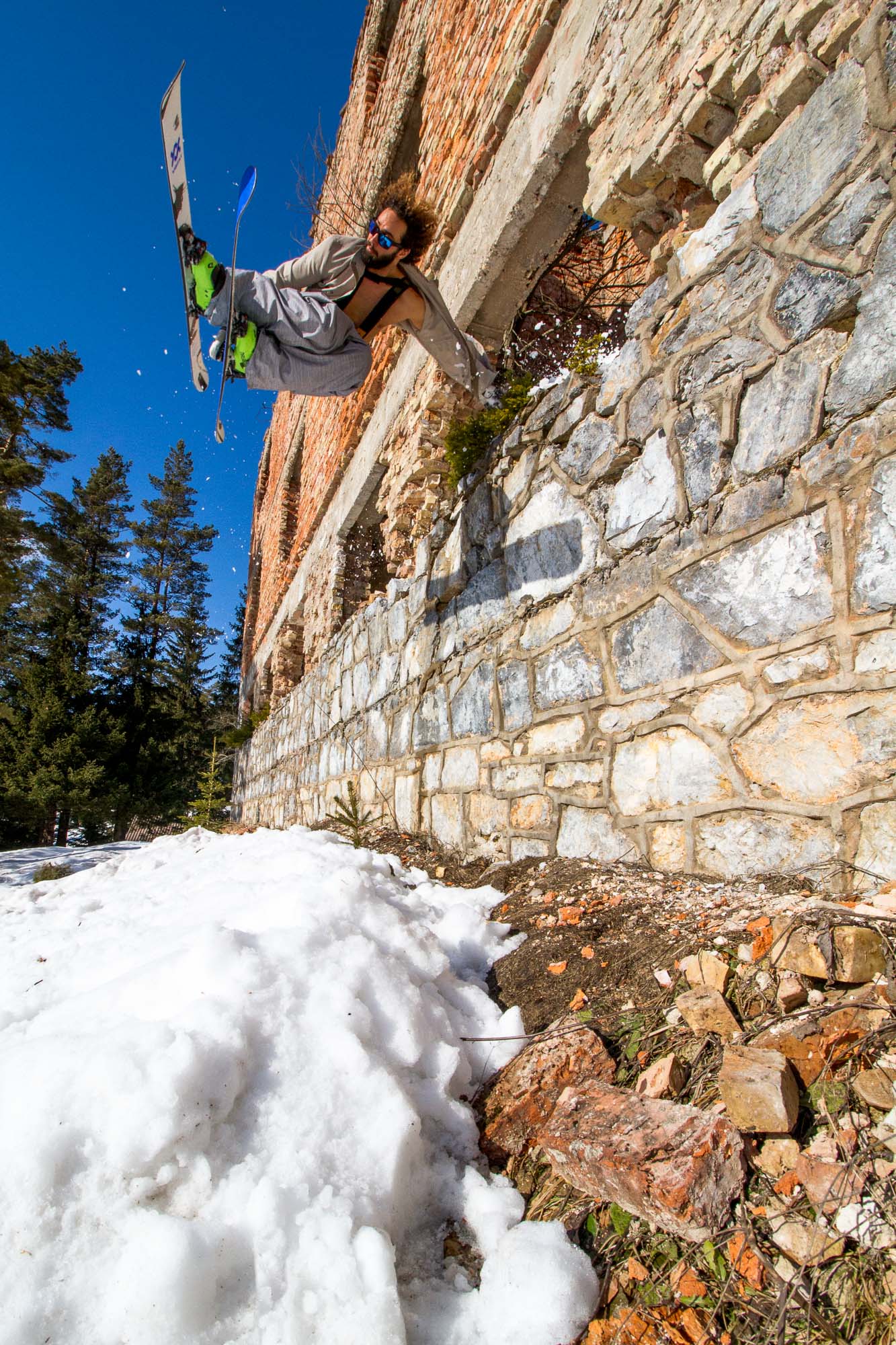
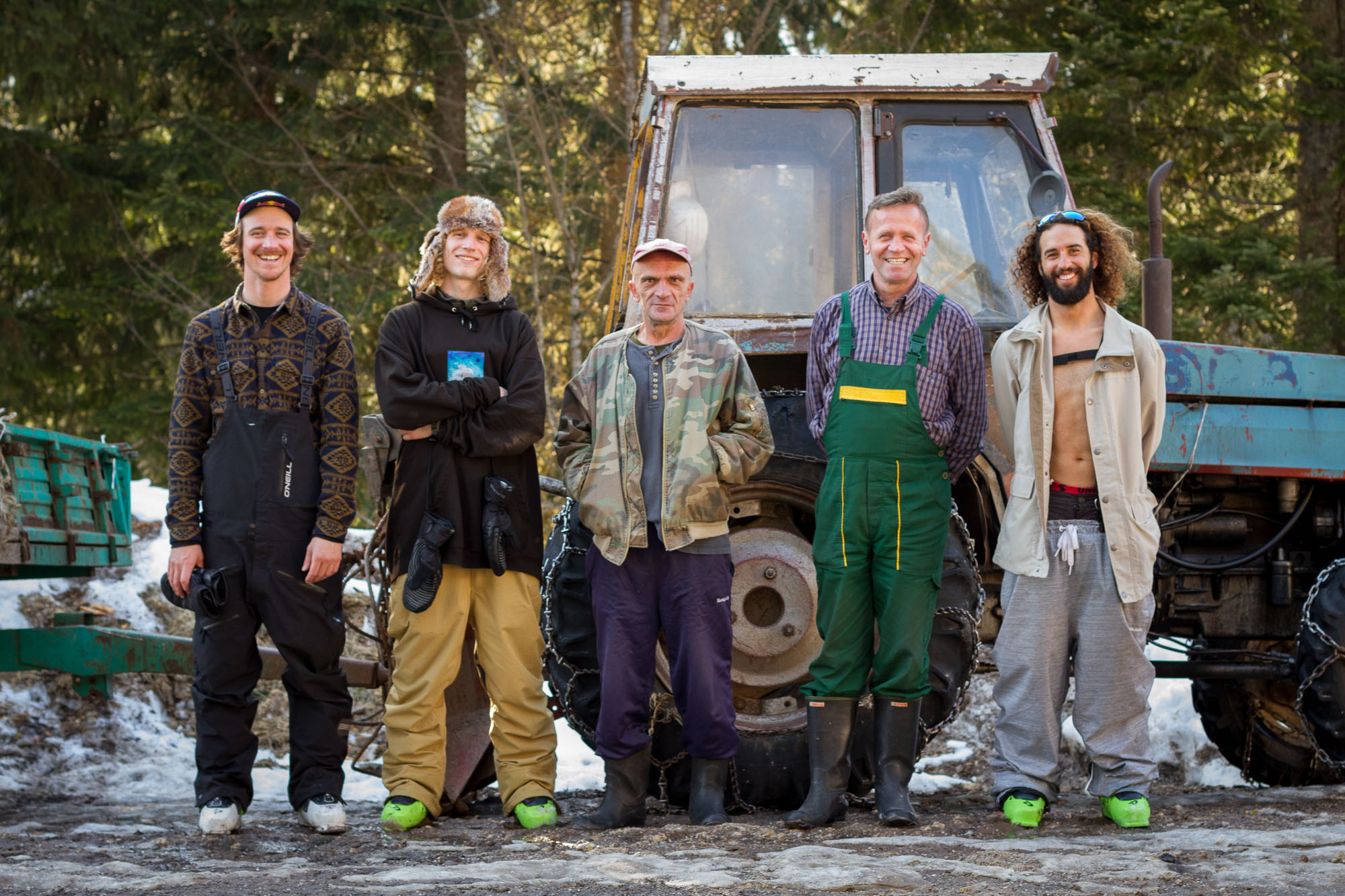
Hanging with our new friends.
We return in the afternoon to the pillow line, where Tom steps up to the challenge and bags a solid line, while Daniel captures the glory shot with his drone. It’s a hell of a way for Tom to cap off three days of skiing in Sarajevo, and we celebrate with a bottle of vokda in the evening, which is quickly gone thanks to Daniel’s efficient Russian methodology. “Everyone drinks three before you leave the table!” he commands.
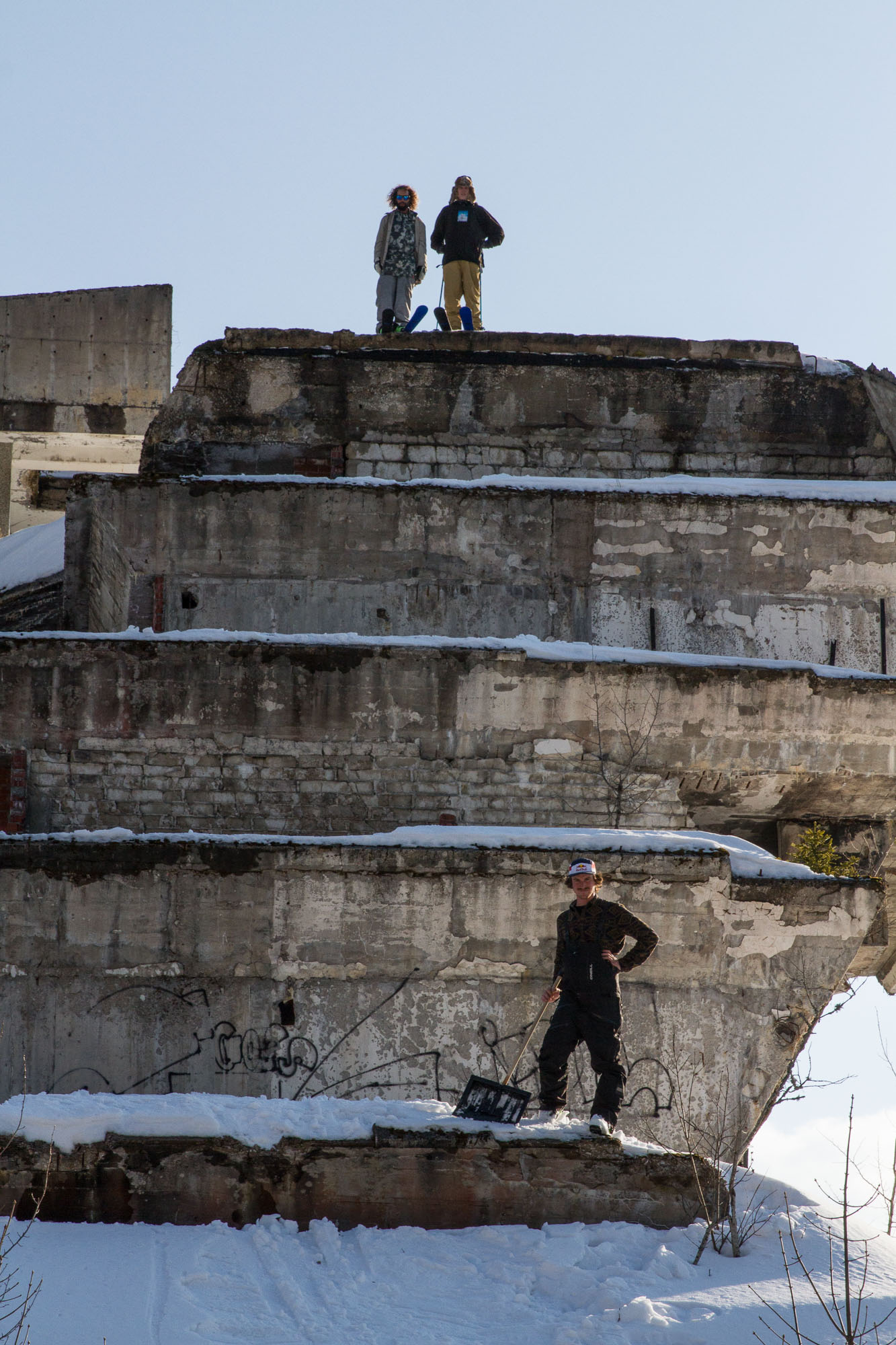
Scoping the line.
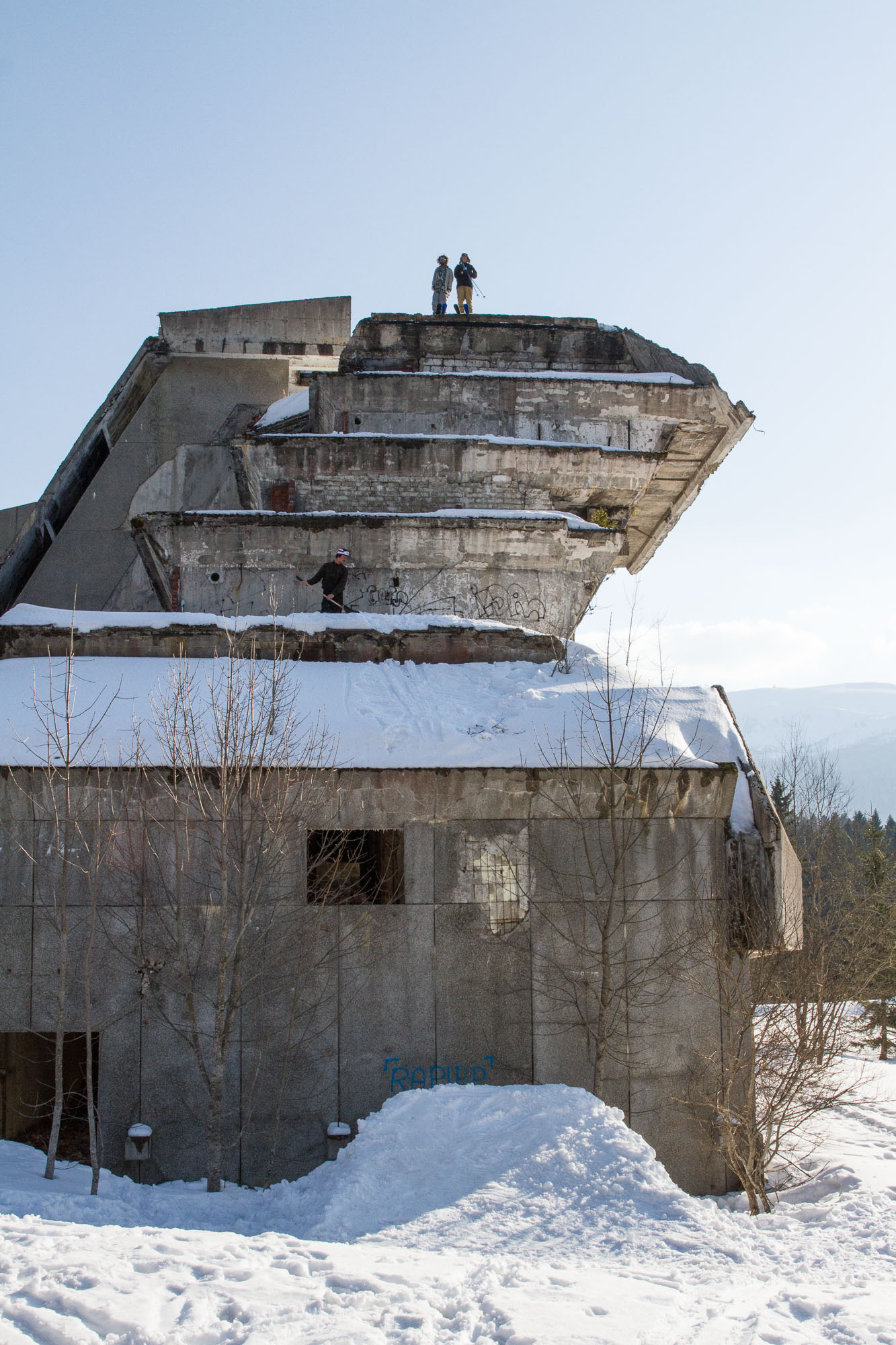
Seems casual...
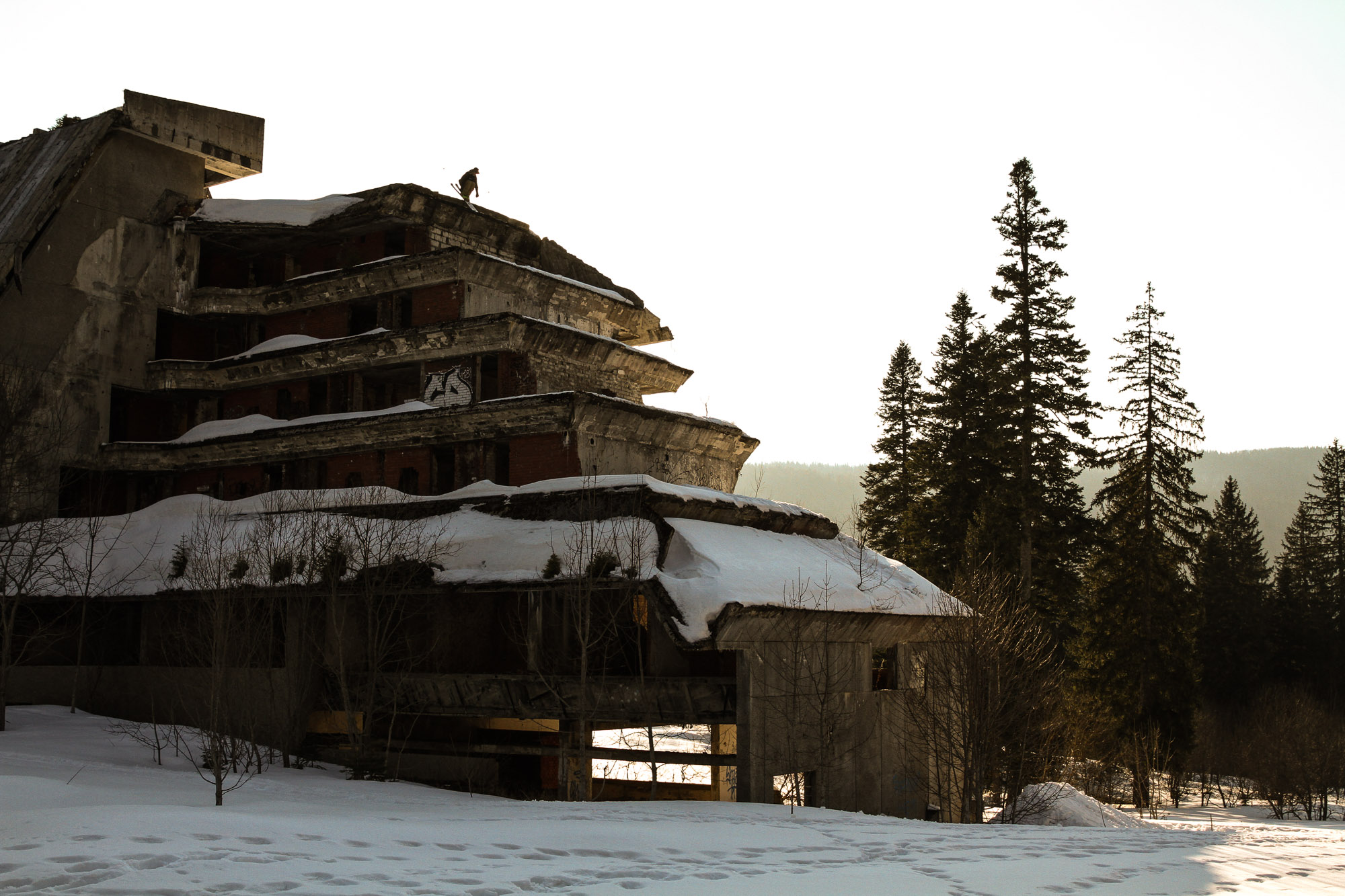
Dropping!
Day 5: The Tunnel of Hope
Tom and Paddy somehow make their flight out early the next morning, and Daniel is back to Moscow soon afterwards. Ahmet, Jonathon and I spend the afternoon at the Tunnel of Hope, a 960-meter tunnel running underneath the Sarajevo airport. During the war, this tunnel was the only route in and out of Sarajevo, providing an essential lifeline to the city’s defenders during the nearly four-year siege. We’ve been out playing in the war ruins like children, but now the brutal realities of Sarajevo’s recent history come closer. Mortal shells suspended over our heads speak of the harrowing days here when anyone walking the streets of Sarajevo could become a victim of war.
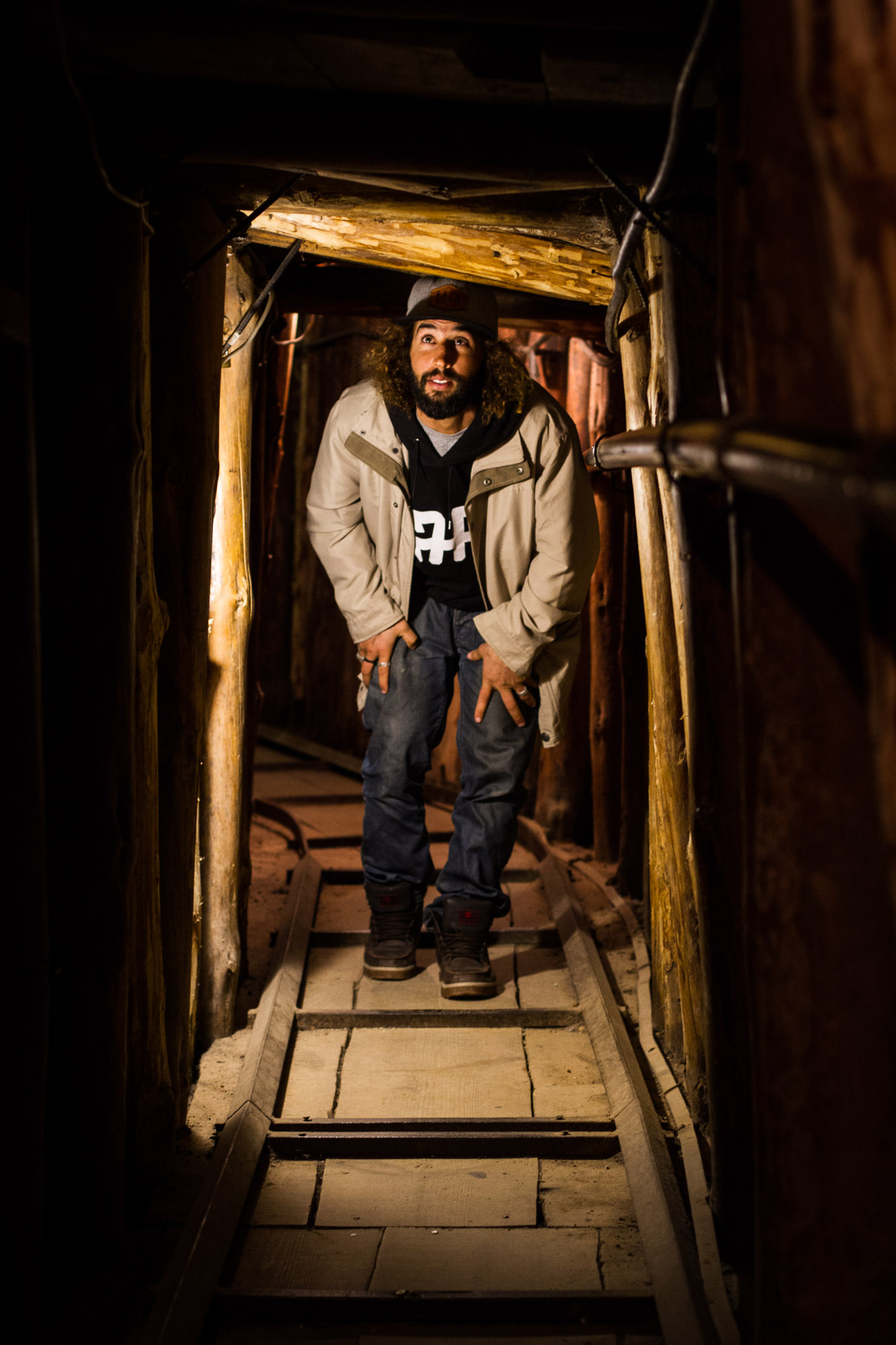
Tunnel of Hope
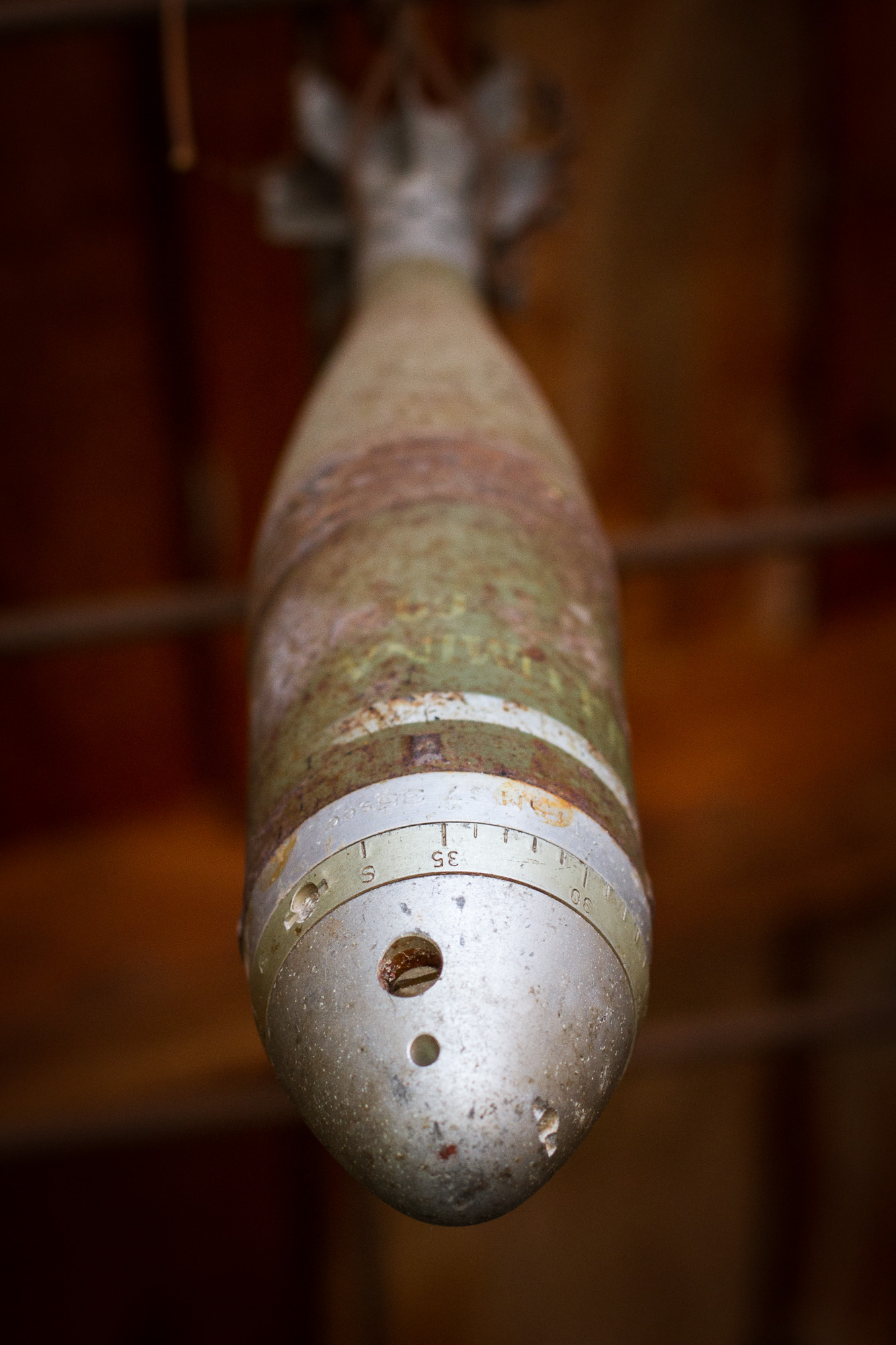
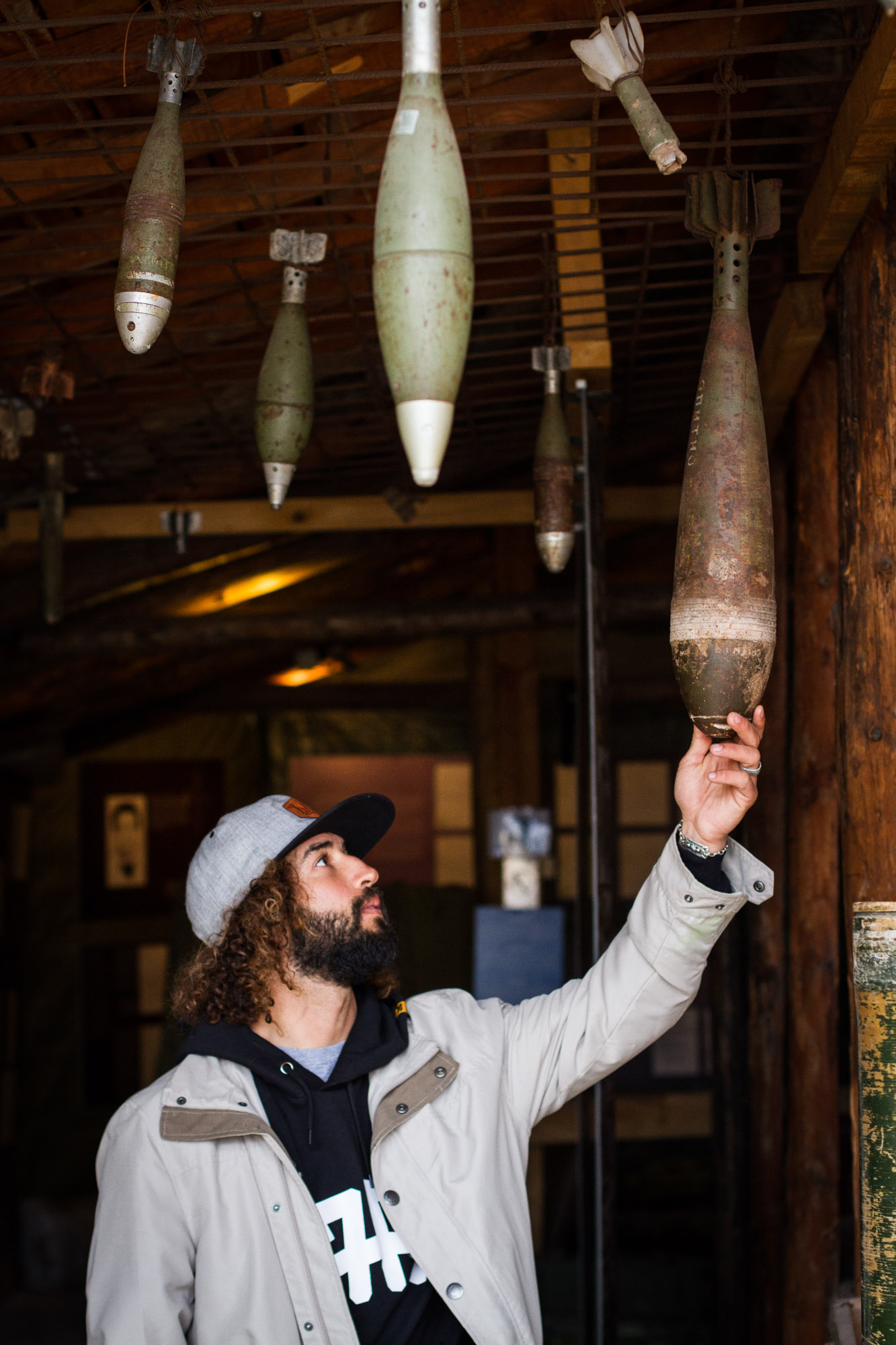
Sarajevo´s a great place, but it can wipe the smile off your face real quick.
“We had the Olympics here, and then ten years later we had a different kind of Olympics—between the snipers in the hills and the people in the street,” a tour guide at the tunnel tells a tourist—explaining the infamous “sniper alleys” of Sarajevo where residents risked their lives to cross. “It was a kind of race—who will win? Can you imagine?” Sections of the city’s tram line were under regular fire throughout the siege. Riders would sit quietly in their carriages in these sections, hoping today wasn’t the day the tram would be hit. Back at the AirBnB, I ask Iman about the siege, which she lived through as a child. “We don’t like to remember those times,” she says diplomatically—noting that her father, her grandfather and many other family members lost their lives in the conflict. In a country still trying to rebuild from this savage conflict, most prefer to look towards the prospects of the future. The scars of the past are still too new.
Day 6: Last Shots
After a day off in the city, Ahmet, Jonathon and I return to Igman for our last day on snow. Ahmet still has a line he wants to get on the hefty five-stage bomb drop, and with a day of rest under his belt, he’s quickly able to get it in the bag. With time left for one more feature, we start building another line: another drop out of a window, riding down the side of the hotel to get speed for a consequential gap jump over a ledge. After a few speed tests, Ahmet calls it off — the rusty nails and rebar sticking out of the concrete give pause for thought, and the gap is just too hefty for any doubts or tired legs. Remembering another quarterpipe wallride trannyfinder we haven’t built yet, we quickly toss it together and Ahmet gets one more shot to complete our mission and leave the spot satisfied. Shots are in the bag — now it’s time to spend one more day in the city before we head our separate ways.
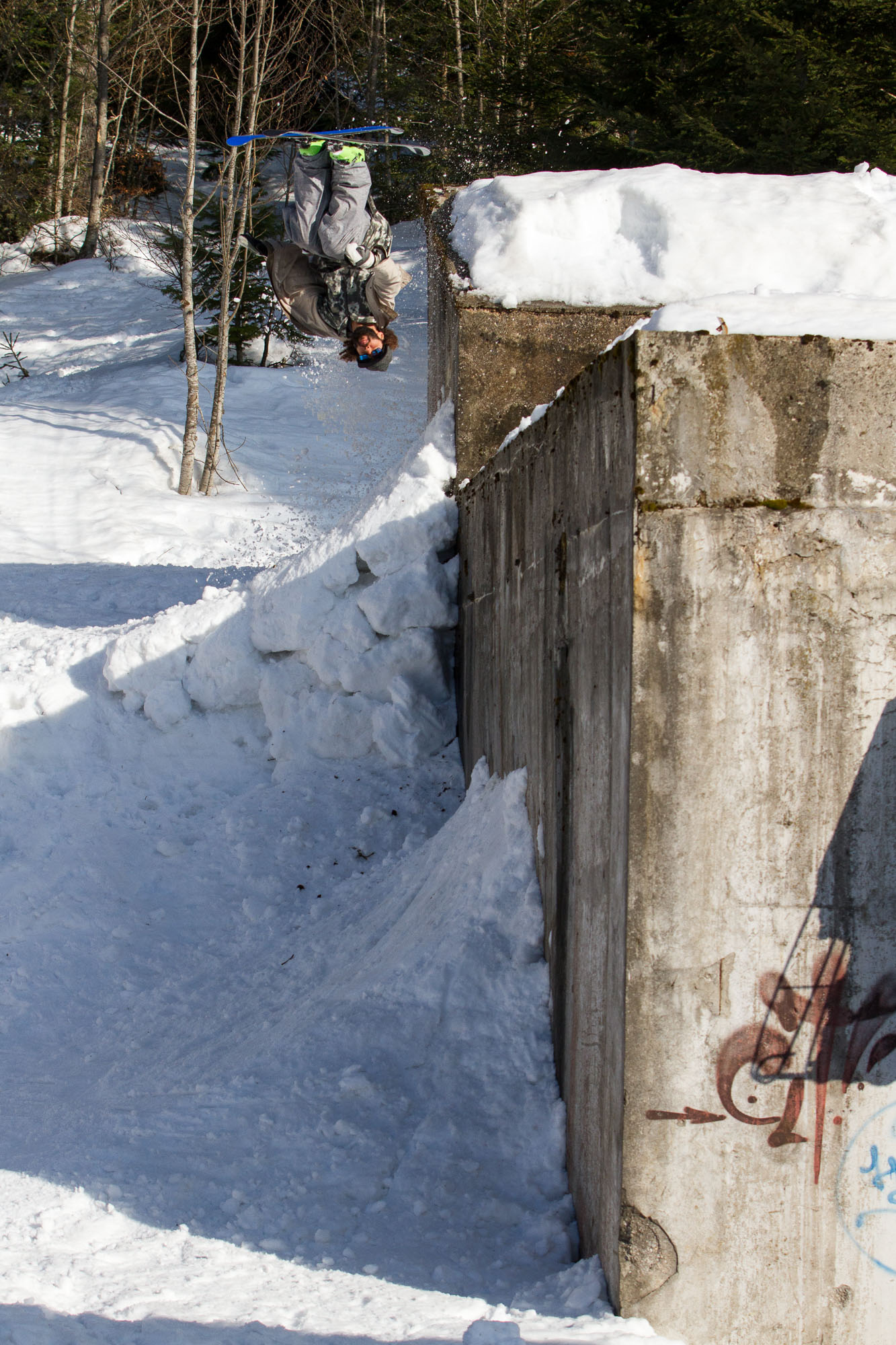
Day 7: The horror of war
We hop on the tram into Sarajevo early for a full day in town. Our first stop is the Latin Bridge over the Miljacka River in the heart of the city, the site of the assassination of Archduke Franz Ferdinand by a Yugoslav nationalist, Gavrilo Princip, which led to the start of the First World War. There is little more than a plaque to mark the site, after previous monuments were altered or removed depending on the government in charge. Over a hundred years after the act, it’s still not settled in these parts who was the hero and who was the villian when Gavrilo shot Franz.
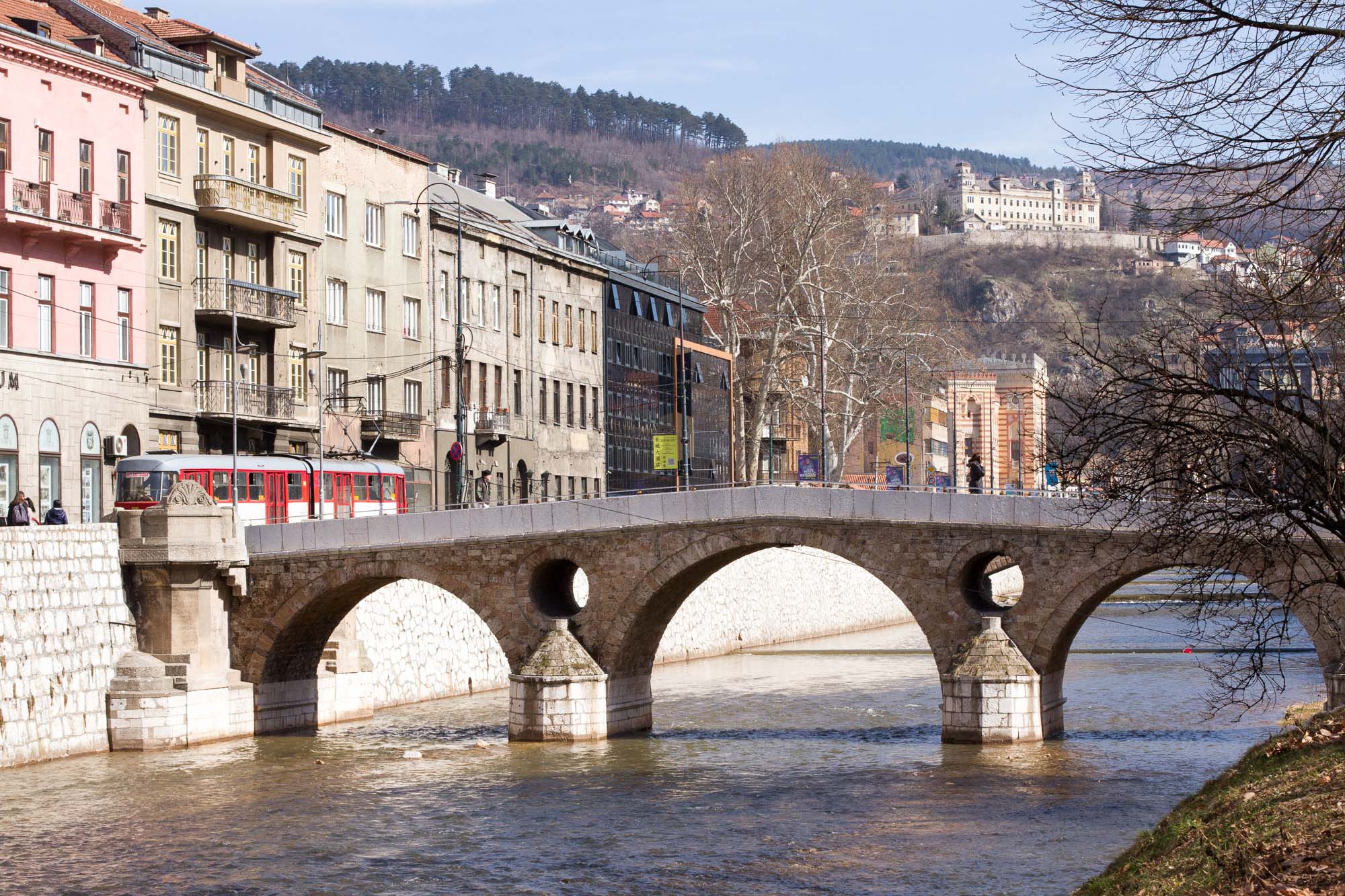
The Latin Bridge, where Franz Ferdinand´s driver took a wrong turn and inadvertently started World War I.
Our next stop is the Emperor’s Mosque, a historic structure dating to 1457 and the Ottoman conquest of Bosnia. Jonathon and I slip off our shoes and head inside for a look, while Ahmet performs wudu, the traditional washing procedure, before joining us for salah, the prayer. A helpful young man attached to the mosque invites Jonathon and I to stay and film. It is my first time witnessing an Islamic prayer and I have no idea what to expect. The men move to the front—some hurrying in late—while the women stay in their reserved space in the back. There are multiple repetitions of standing, bowing and full prostration, performed individually, before the men crowd forward into one compact mass to perform the movements in unison, guided by a young mullah. After the rituals are complete, the assembly breaks up with greetings and chit-chat, like any religious service anywhere in the world, before we all spill back out into the bright sunshine of the streets.
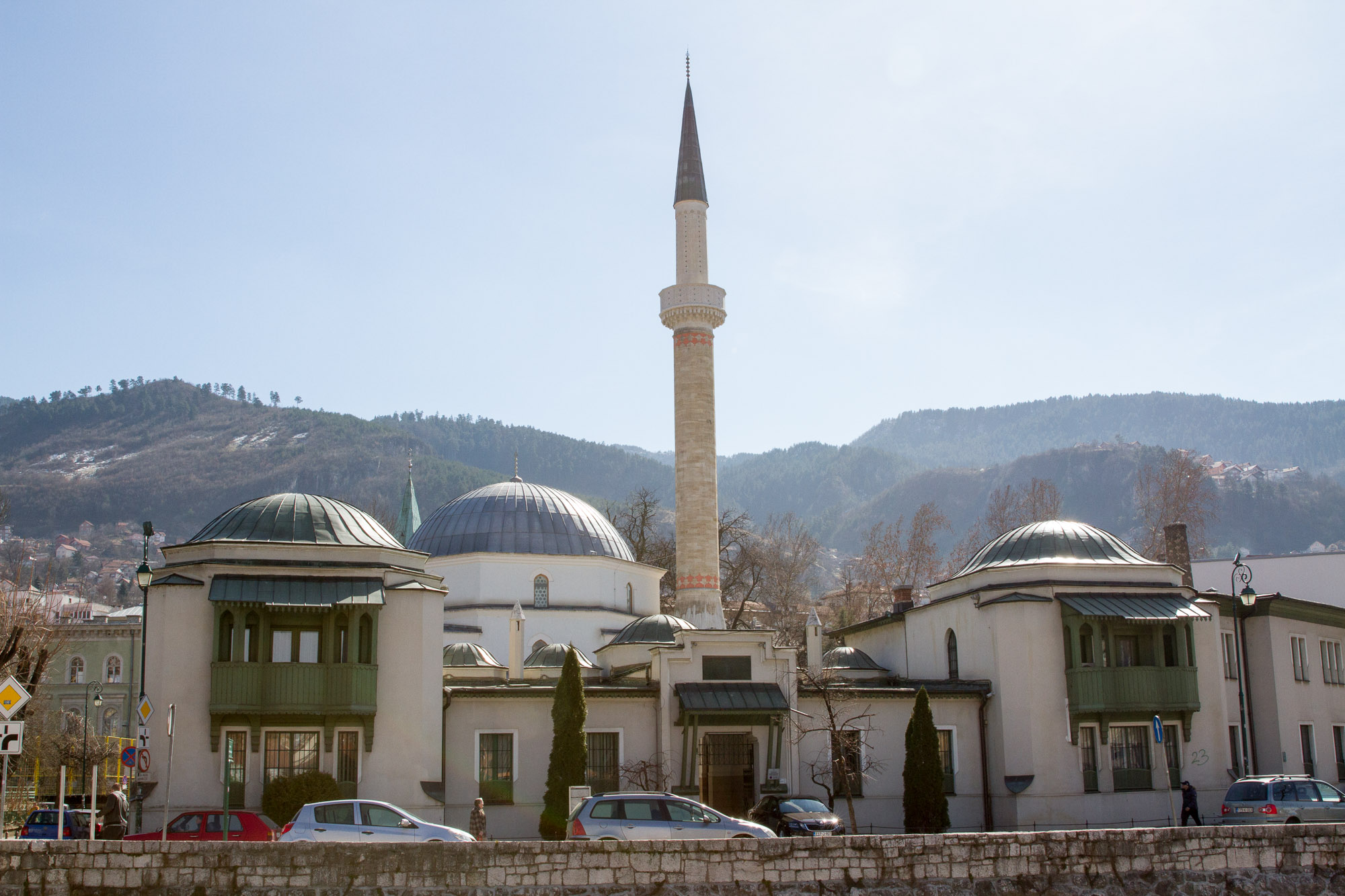
The emperor´s mosque.
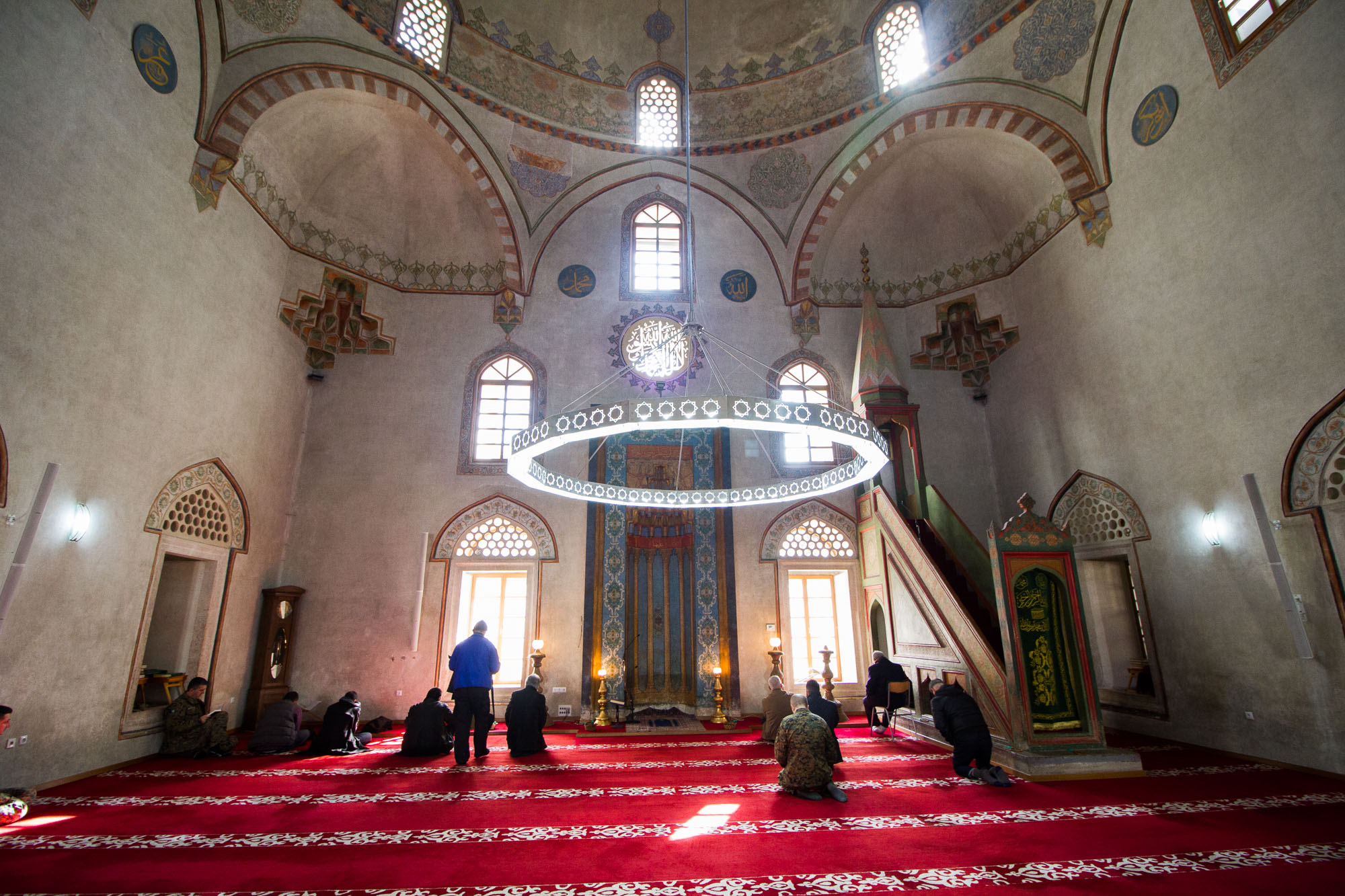
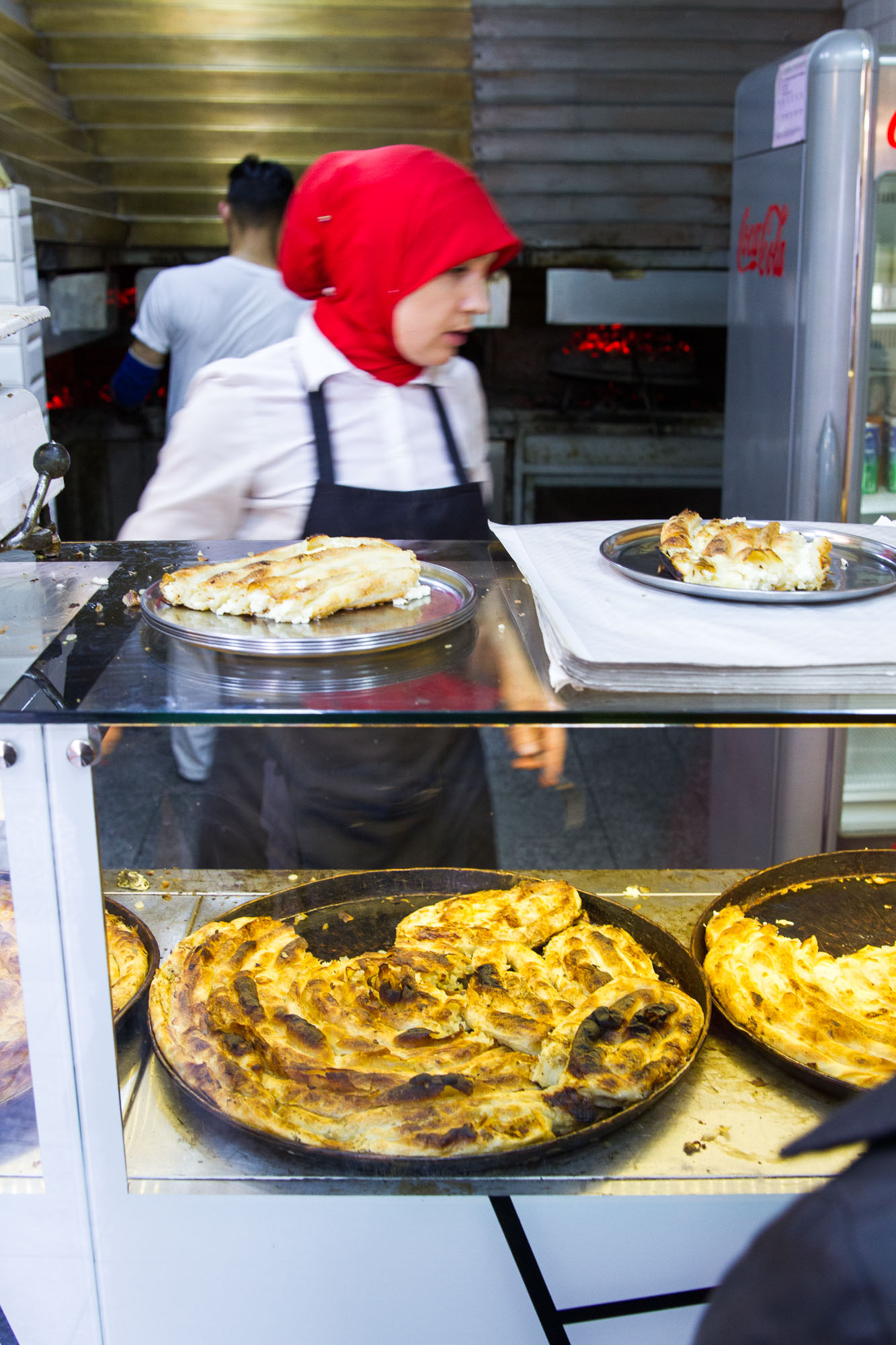
Mmmm, burek.
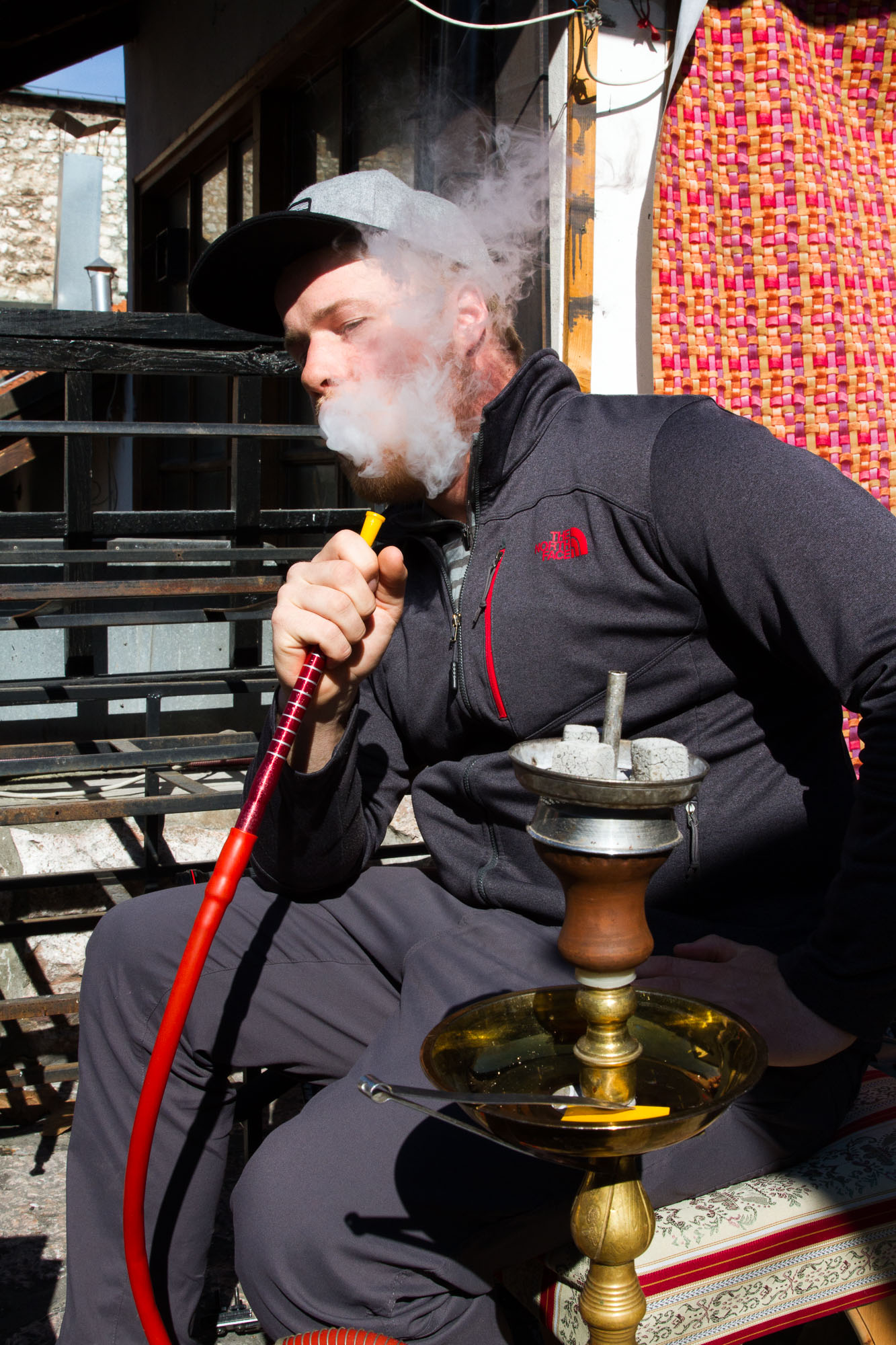
Jonathon chiefing "Baku Nights."
After a midday break for a hookah smoke and tasty burek pastry for lunch, we head for Sarajevo’s Museum of Crimes Against Humanity and Genocide. Inside, stories of the survivors and the victims of the Bosnian war are recounted in harrowing personal detail. Each story is accompanied by innocuous-looking objects with tragic histories: the blouse of a young girl who was murdered in the streets. Makeshift guns built from water pipes cobbled together by Sarajevo’s defenders. Police batons and wire-wrapped clubs used to beat prisoners; pliers and wires used to pull toenails and mutilate genitals in torture chambers. Around every corner awaits a new atrocity to contemplate. We are moved to tears in the face of this raw horror and brutality. It is impossible to visit this place and leave the same as you were before. Any visitor to Sarajevo must go there.
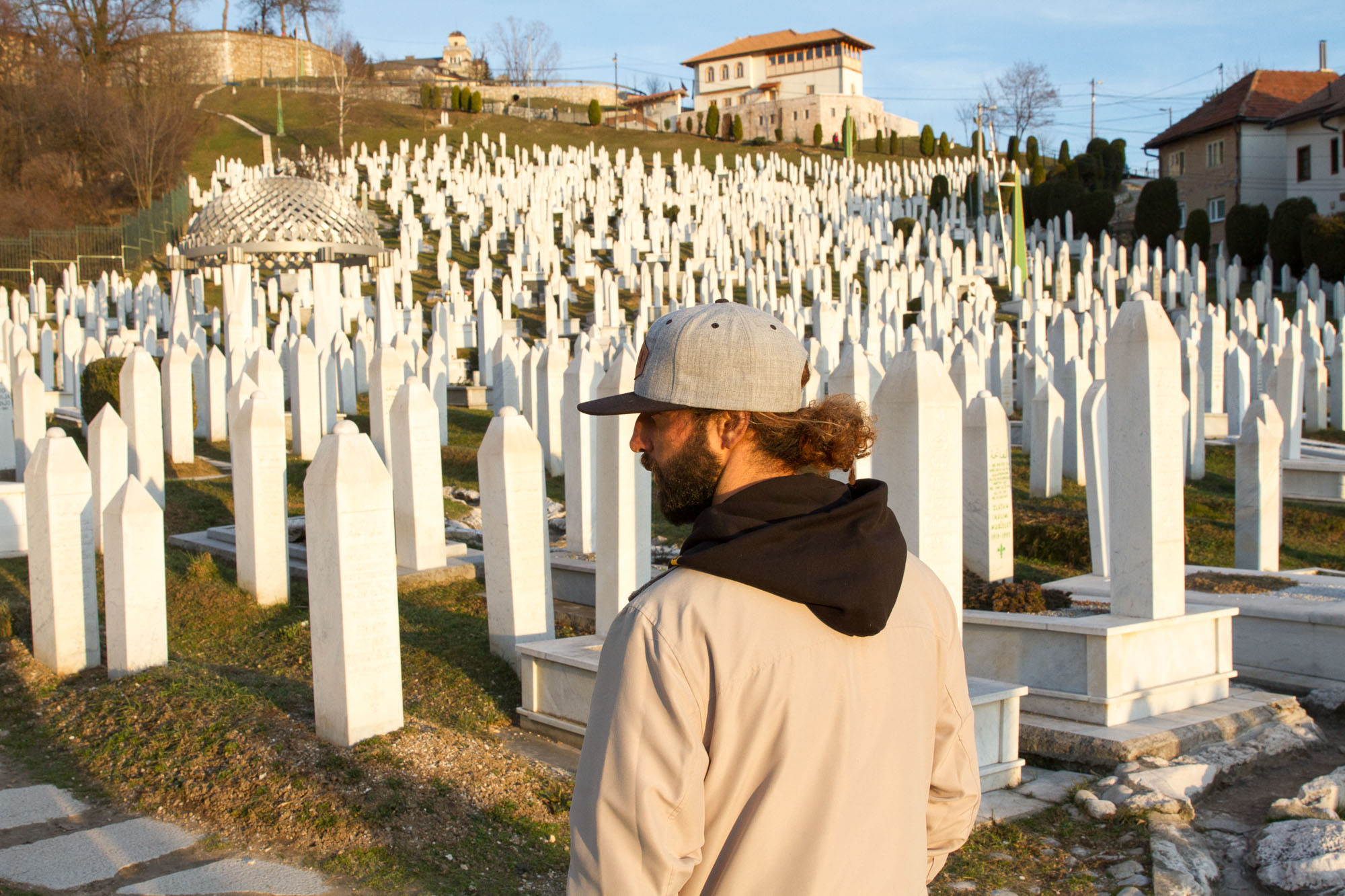
Stunned into silence by the museum, we head back out into the waning light of day and make our way towards the White Fortress, a bastion overlooking the old town, for a view of the sunset. Along the way, we have to cross one of Sarajevo’s ubiquitous cemeteries: countless rows of white gravestones pointing at the sky, the date of every death between 1992 and 1995. Again the unspeakable horror of this war washes over me, and I have to pull myself together. We sit in silence at the White Fortress, and watch the sun descend through a blood-red sky to the horizon.
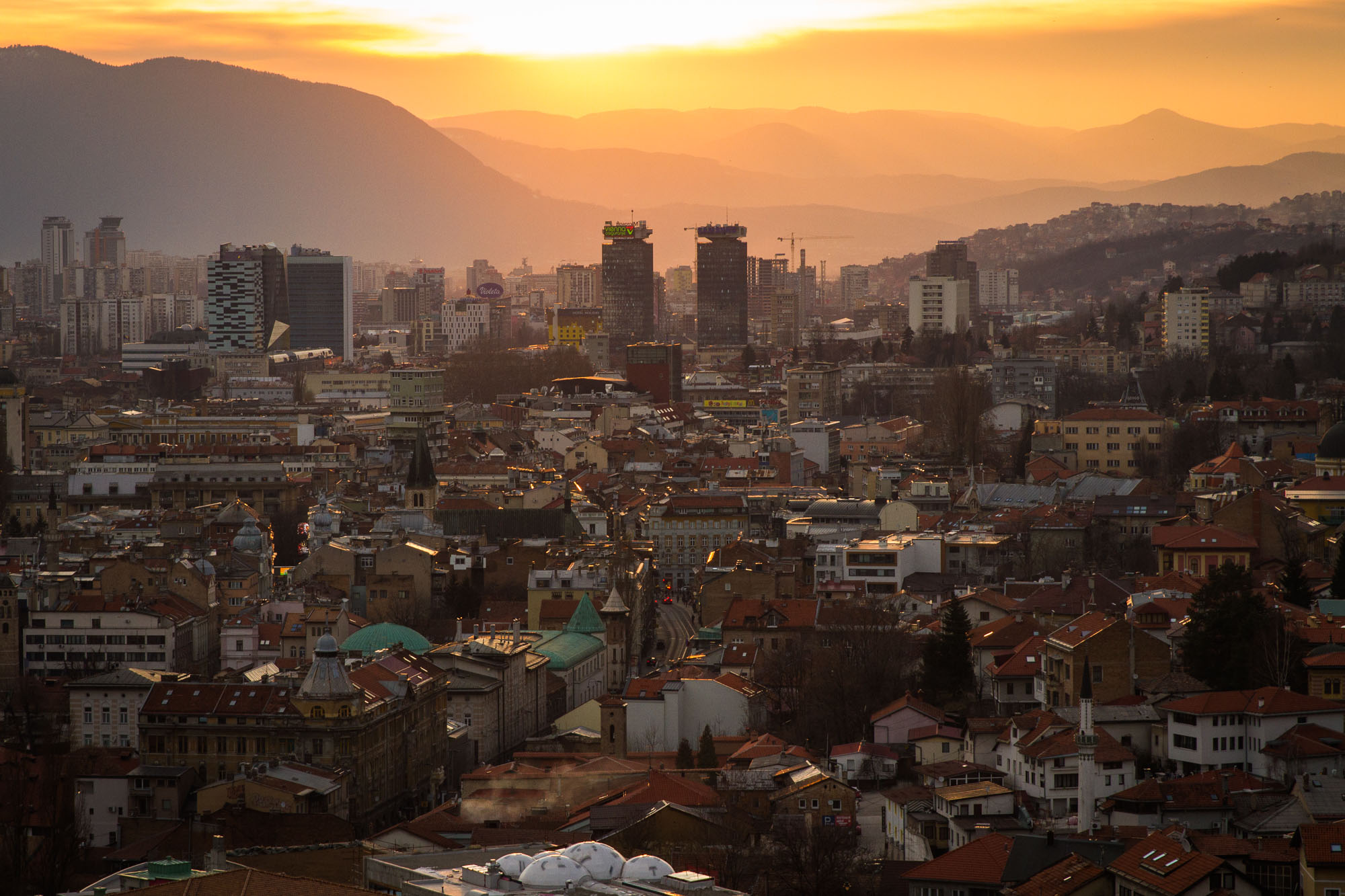
It is impossible to visit this place and leave the same as you were before.
What the hell happened here? After the 1980 death of Josip Tito, the strongman who held the multi-ethnic state of Yugoslavia together for four decades, the seams holding the country together began to loosen. In 1991 both Slovenia and Croatia declared their independence — the Slovenes quickly securing their territory in the Ten-Day War, while the Croats didn’t have it quite as easy. A year later, Bosnia tried to do the same—with disastrous consequences. Slovenia and Croatia’s populations were mostly ethnically uniform, but Bosnia is a patchwork of Bosniaks (Bosnian Muslims), Serbs and Croats. The minority Bosnian Serbs, still loyal to the Serb-dominated Yugoslav government in Belgrade, took control of their regions, declaring a separatist Serbian Republic within Bosnia, while the newly formed Army of Bosnia and Herzegovina struggled to maintain its hold in Muslim-majority regions. Serbian forces closed in around Sarajevo, holding a siege of the city for 1,425 days while deliberately targeting hospitals, schools, cultural landmarks and civilian centers with artillery. Nearly 14,000 people were killed in Sarajevo alone, while ethnic cleansing and genocidal paramilitary squads swept across the rest of the country: Serbs killing Bosniaks, Bosniaks killing Serbs, and Croats killing and being killed by both. Over a hundred thousand people died, and millions more were displaced, before the United Nations finally took decisive action to end the conflict in 1995.
This is not ancient history. This happened just over twenty years ago, right in the middle of supposedly civilized Europe: people, killing, torturing, maiming and raping each other based on misguided concepts of religion, ethnicity and nationalism. This is what happens when humans stop perceiving other humans as human. This is the tragic cautionary tale that Sarajevo, a war-torn city still rising from the ashes, has to tell its visitors — a tale that, in today’s political climate, is sadly more relevant than ever.
Our trip to Bosnia is at its end. I’m on a plane back to Zurich, while Ahmet and Jonathon begin the long drive back to the Alps in search of the next Vanventure destination. We came to play in the ruins of war. We had our fun, then had our eyes opened. Not every ski destination comes as heavy as this. Which makes it even more worth it to visit.

